Famous Works of Art That Took a Long Time
Public Domain // Wikimedia Commons
50 famous paintings and the stories behind them
A picture is worth a thousand words, and similar texts, art is oftentimes meant to exist "read" through disquisitional deconstruction. Paintings can be far more complicated than they appear at offset glance and difficult to decipher if the viewer doesn't speak the same tongue. Iconography—the symbolic language of a given work of art—can be sophisticated and complex, reflecting the collective consciousness or fatigued from the artist's personal experience. Why would someone eschew the written word in favor of paint and canvas? 20th-century American artist Edward Hopper appears to take had the reply. "If I could say it in words," he said, "there would be no reason to paint."
The stories told past works of art—and virtually them—are, quite literally, the stuff of novels. Johannes Vermeer's "Girl with a Pearl Earring" inspired the novel of the same name by writer Tracy Chevalier. The volume was subsequently turned into a film starring Scarlett Johansson. Almost xl years later Irving Stone wrote his biographical account of the life of Michelangelo, Dan Dark-brown's "The Da Vinci Code" turned the life and work of the Renaissance master into a romp through the preceding millennia.
September 2019 heralded the wide cinematic release of the latest exponent of the genre: "The Goldfinch," based on Donna Tartt's Pulitzer Prize-winning novel. The book centers effectually the fictionalized theft of Dutch artist Carel Fabritius' eponymous painting after an explosion rocks New York's Metropolitan Museum of Art. Ironically, Fabritius died in a devastating gunpowder explosion in 1654, soon later completing his well-nigh memorable work. The success enjoyed past Tartt'southward book elevated "The Goldfinch" to rock star status, mobbed by crowds determined to take hold of a glimpse of the tiny bird tethered by a delicate chain. [Note: Fabritius' painting is not featured in Stacker'due south gallery.]
Stacker curated this list of some of the globe's most famous images and the fascinating stories behind them. Coil through the listing and find out which paintings scandalized Paris, were looted by the Nazis, and inspired a hit Broadway musical.
Y'all may also like: The 51 women who have won the Nobel Prize
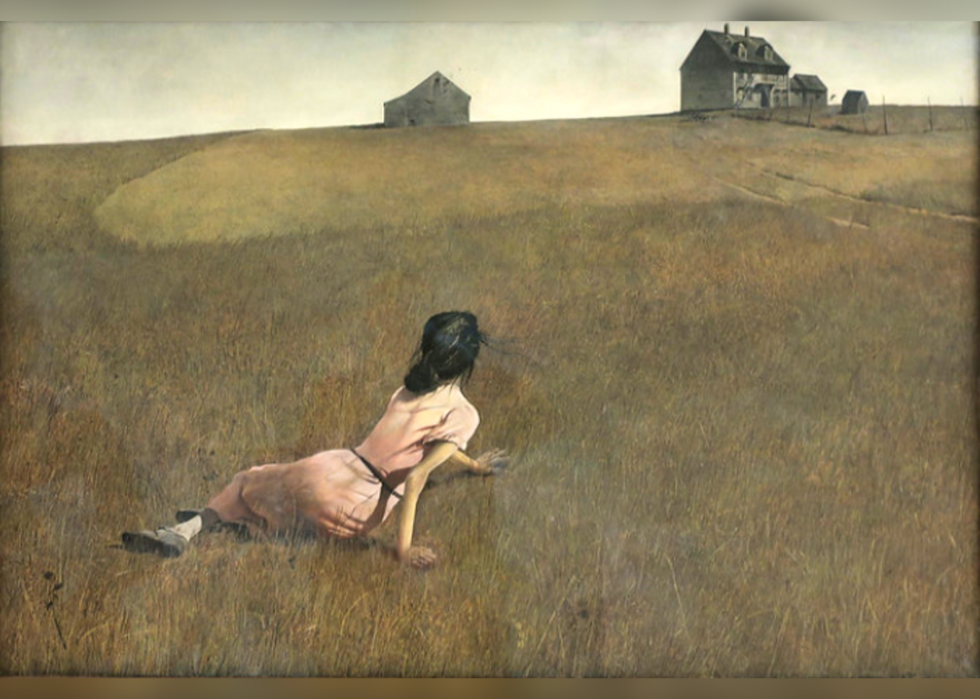
i / l
Christina'due south Earth
- Artist: Andrew Wyeth
- Yr: 1948
"Christina's World" continues to fascinate more than lxx years subsequently information technology was kickoff painted. The faceless woman lying on the ground was Anna Christina Olson, the neighbor and muse of Pennsylvania artist Andrew Wyeth. While the painting has all the hallmarks of a pastoral, Olson'southward pose is not ane of romantic lethargy; she suffered from a musculus-wasting disorder—possibly Charcot-Marie-Tooth illness—and was known to drag herself across the family homestead.
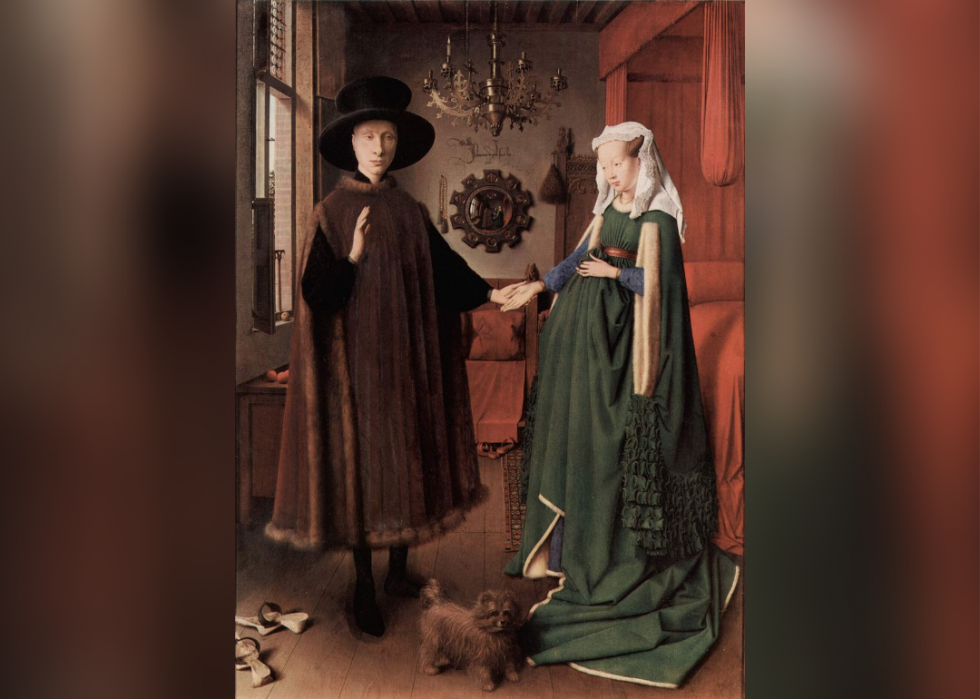
ii / 50
Public Domain // Wikimedia Commons
Arnolfini Portrait
- Creative person: Jan van Eyck
- Twelvemonth: 1434
Painted by Dutch chief Jan van Eyck, this early on Netherlandish console painting is shrouded in symbolism. The elegantly dressed couple are thought to be Giovanni di Nicolao di Arnolfini, and his wife, Costanza Trenta, wealthy Italians living in Bruges. The unusual composition begs several questions. Does the painting celebrate the couple's wedding, or commemorate some other event, such equally a shrewdly negotiated marriage contract? Was the bride significant, or simply dressed in the latest fashion? And what are the mysterious figures depicted in the convex mirror? The unorthodox placement of van Eyck'south signature directly above it suggests ane of the men may be the artist himself.
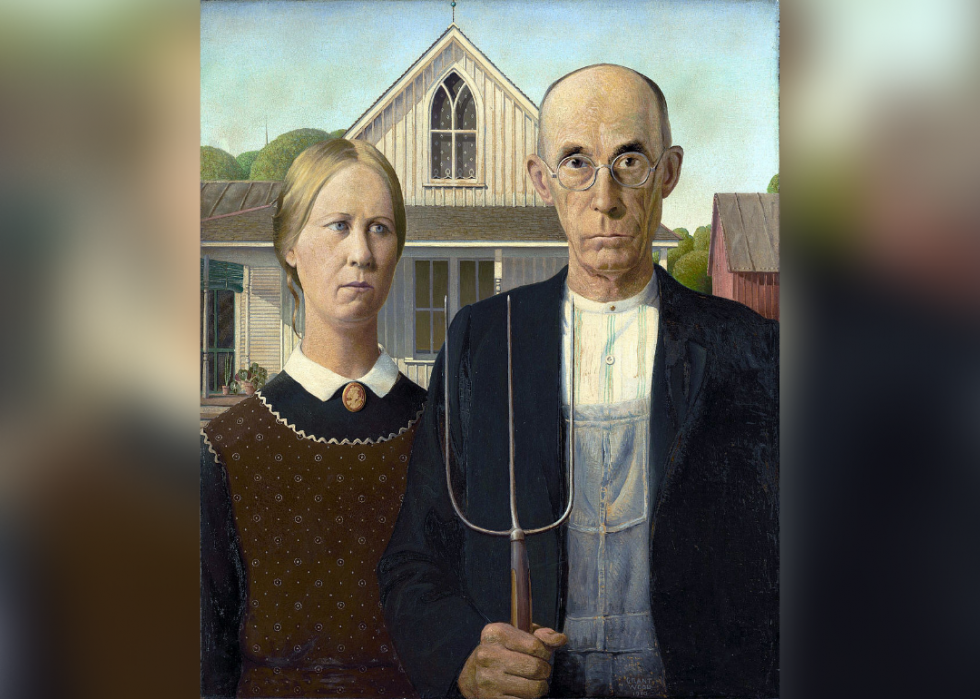
3 / 50
Public Domain // Wikimedia Eatables
American Gothic
- Artist: Grant Woods
- Yr: 1930
Grant Wood spent years searching for inspiration in Europe. The work that would make him famous, notwithstanding, was painted subsequently his return to the heartland. A national icon and leading exponent of regionalism, "American Gothic" depicts what appears to be a Depression-era farmer and his weathered married woman. Grant intended the couple to represent father and girl; in reality, they were neither. The man holding the pitchfork was Wood'south dentist, Byron McKeeby, flanked by the creative person's sis, Nan Woods Graham.
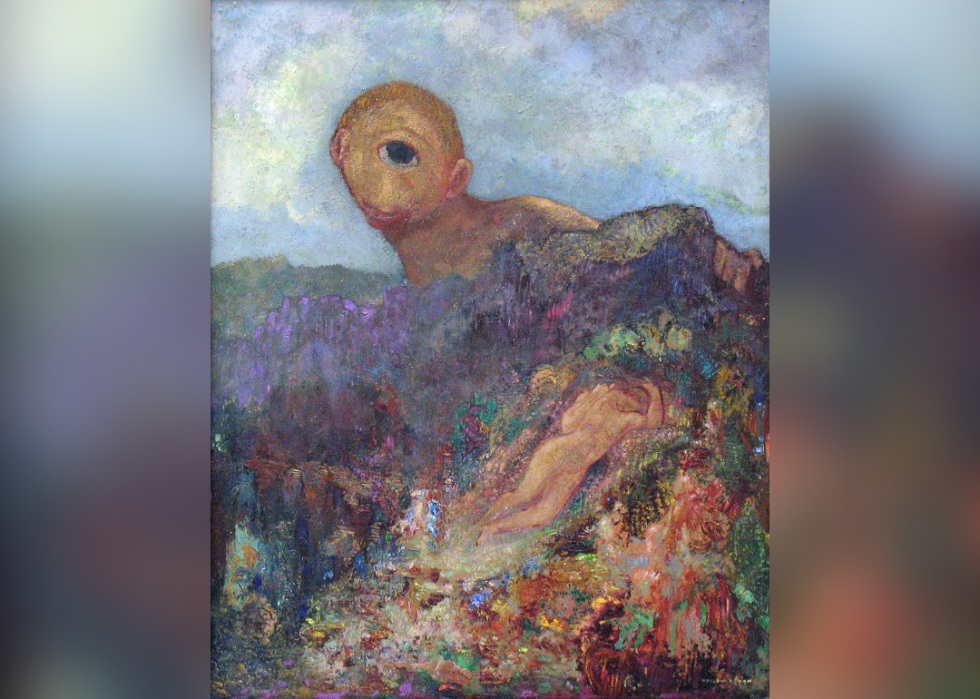
4 / 50
Public Domain // Wikimedia Eatables
Cyclops
- Creative person: Odilon Redon
- Twelvemonth: 1914
For those not familiar with the finer points of Greek mythology, the dream-like discipline of Odilon Redon's "Cyclops" may not be easily identifiable. Polyphemus, the behemothic that is sporting the solitary eyeball, peers over a rocky outcropping at the object of his desire—the nymph Galatea. Derived from Homer's "Odyssey," the tale was a pop trope among French symbolists, including Redon'south contemporary, poet and painter Gustave Moreau.
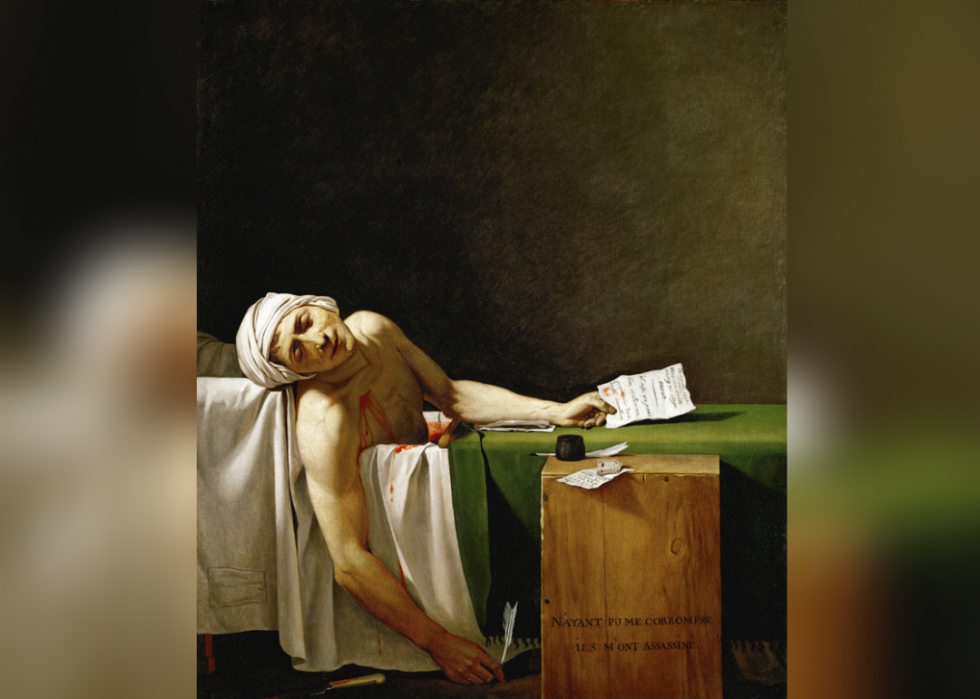
5 / 50
Public Domain // Wikimedia Commons
Expiry of Marat
- Artist: Jacques-Louis David
- Year: 1793
The pallid figure bleeding out in Jacques-Louis David's 1793 neoclassical masterpiece is none other than Jean-Paul Marat, the French revolutionary famously stabbed to death in the bath by political adversary Charlotte Corday. David gravitated toward radical politics, aligning himself with the Jacobin ideologies of Marat and Maximilien Robespierre. In post-revolutionary French republic, he rose to the position of court painter under Napoléon Bonaparte.
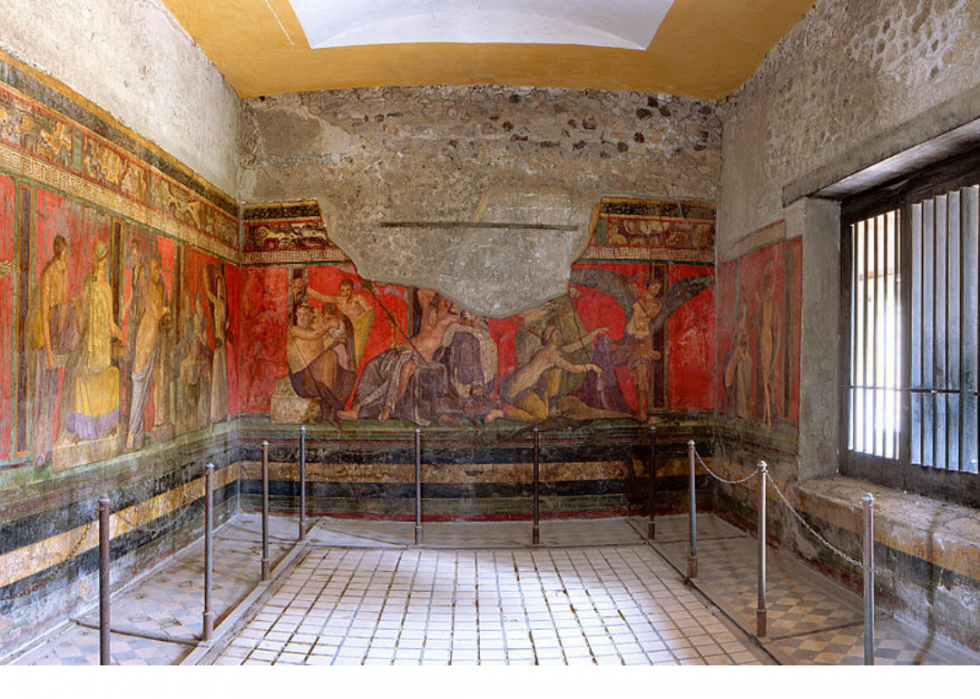
6 / l
MatthiasKabel // WikimediaCommons
Frescoes, Villa of the Mysteries
- Artist: Unknown
- Twelvemonth: c. starting time century B.C.
In 1909, archeologists working in the ancient Roman city of Pompeii unearthed a villa buried under xxx feet of volcanic ash. Preserved inside was a room, measuring approximately 225 square feet, containing a series of cute notwithstanding baffling frescoes. The images depict more than than two dozen, life-size figures. At the centre of the activity is a clothesless woman, shown flogged in one scene while dancing and playing the cymbals in another. About scholars concur that the cycle represents a Dionysian initiation cult.
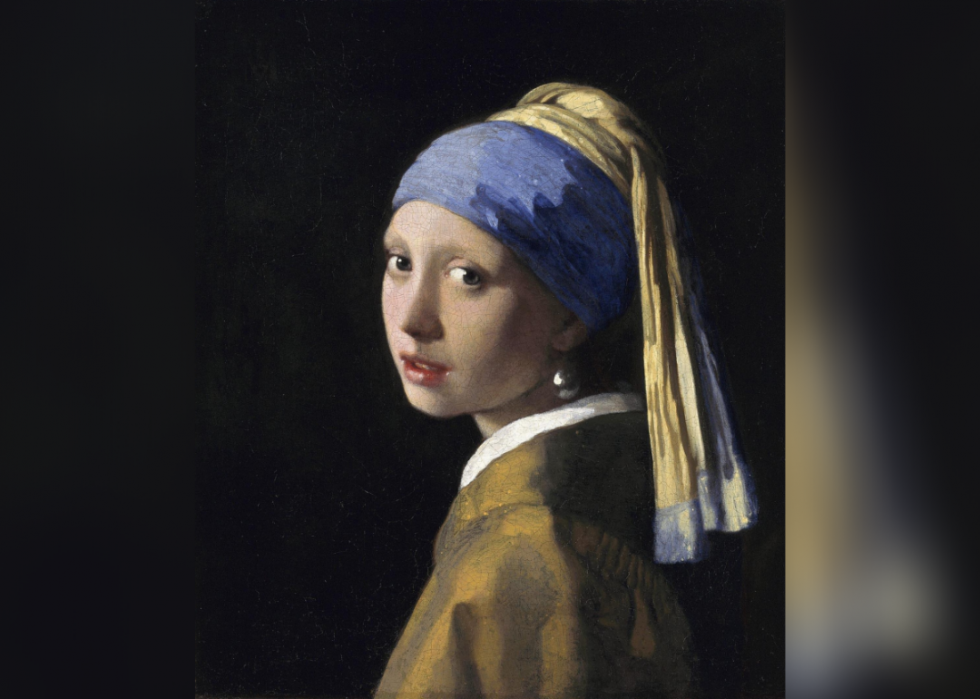
7 / 50
Public Domain // Wikimedia Commons
Girl with a Pearl Earring
- Artist: Johannes Vermeer
- Twelvemonth: 1665
A masterpiece of the Dutch Golden Historic period, Vermeer's "Girl with a Pearl Earring" has transfixed viewers with her wistful gaze ever since the painting resurfaced in the belatedly 19th century. Piddling, notwithstanding, is known near the young woman who modeled for the portrait. Information technology has been suggested that the daughter was Vermeer'south daughter or mistress. While this may exist the case, the paradigm wasn't intended to represent an bodily person. The turban worn by the sitter indicates that the piece was intended as a "tronie," an idealized image cloaked in exotic article of clothing.
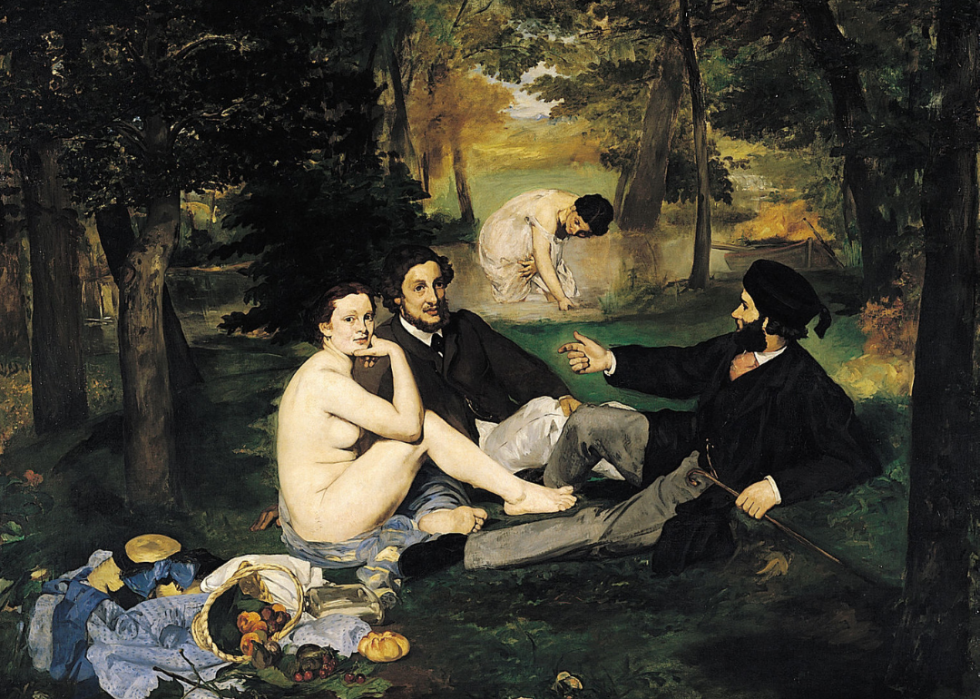
viii / l
Public Domain // Wikimedia Commons
Le Déjeuner sur 50'herbe
- Artist: Edouard Manet
- Year: 1863
Edouard Manet's sensational "Le Déjeuner sur l'herbe" ("The Lunch on the Grass") scandalized 19th-century Paris, not for its stark nudity, but because it broke with a long-standing tradition of depicting nudes in classical settings. The Paris Salon rejected the painting, declaring it obscene. Victorine-Louise Meurent, the naked woman staring unapologetically at the viewer, was causeless by many to be a local prostitute; she was actually a sought-later Parisian creative person's model and an achieved painter in her own right.
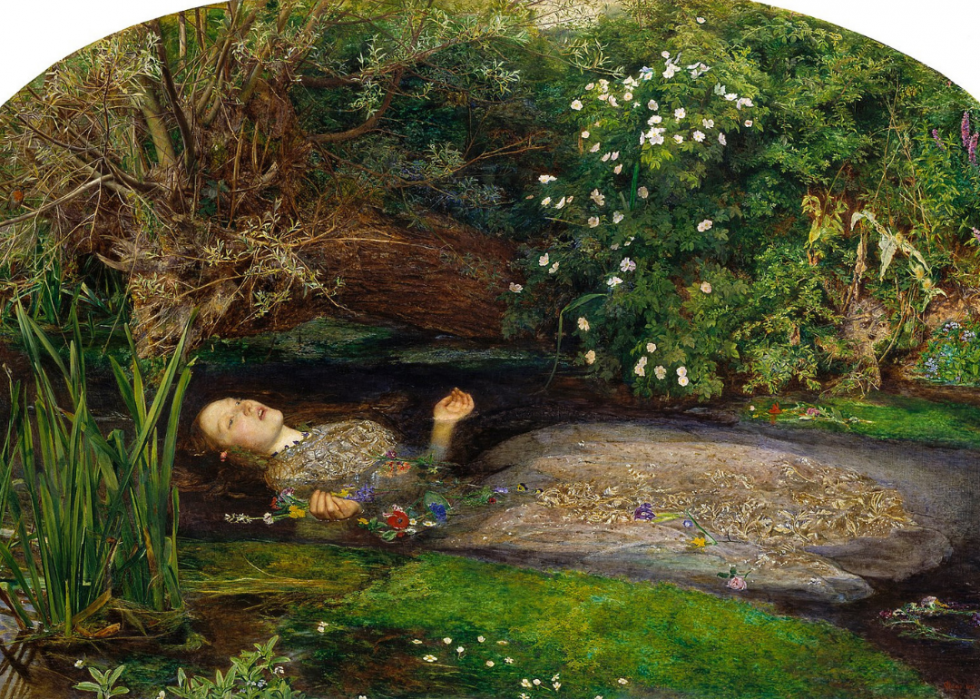
ix / fifty
Public Domain // Wikimedia Commons
Ophelia
- Artist: Sir John Everett Millais
- Year: 1851-52
Pre-Raphaelite John Everett Millais, in true Pre-Raphaelite fashion, painted direct from life whenever possible. Much of the exuberant foliage found in "Ophelia" can be found in Shakespeare's "Village" and was painted en plein air. Millais, however, didn't field of study his xix-year-old model, Elizabeth Siddall, to the elements; she reportedly posed for the artist in a bathtub total of water in his London studio.
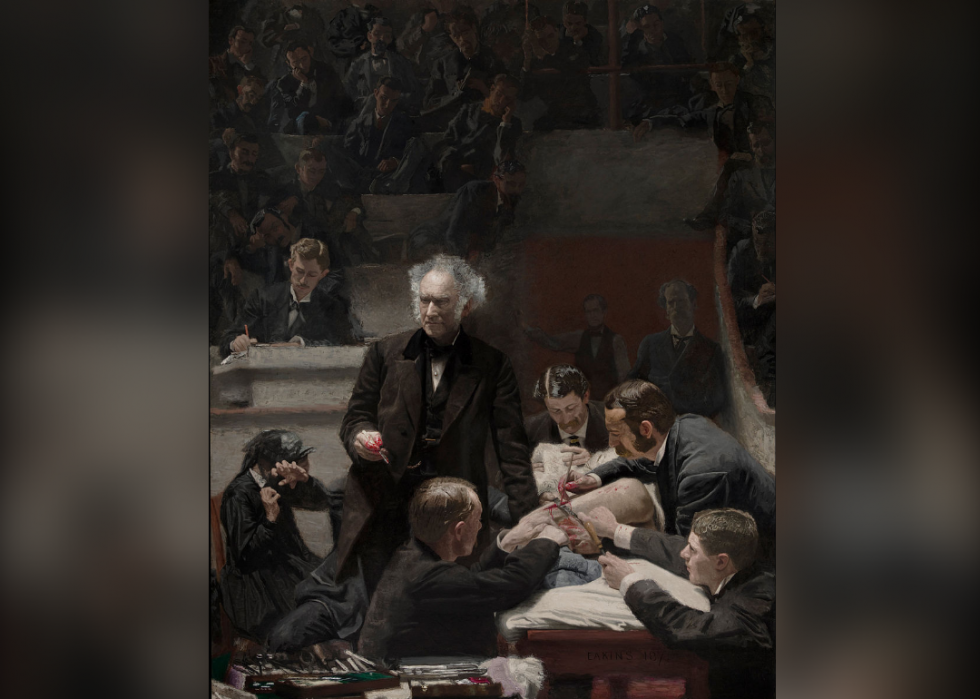
10 / 50
Public Domain // Wikimedia Commons
The Gross Clinic
- Artist: Thomas Eakins
- Year: 1875
Philadelphia artist Thomas Eakins spent a twelvemonth working on "The Gross Dispensary," which he painted specifically for his hometown's 1876 Centennial Exhibition. The closely observed work depicts Dr. Samuel Gross and assembly operating on a patient's leg. A stricken woman hiding her face up from the open up gash has been traditionally identified equally the faceless patient's female parent. Sitting behind Gross, to the right of the painting is a self-portrait of the artist. Jurists, shocked past the gory realism, rejected the work, which was eventually housed in a reconstruction of a U.Due south. Regular army Post Hospital.
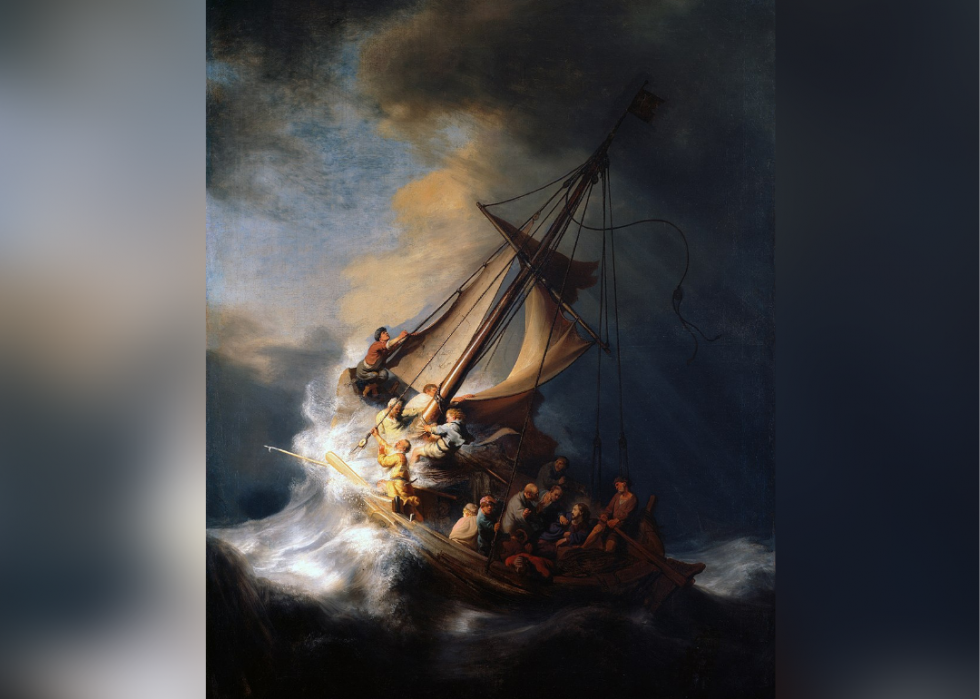
11 / 50
Public Domain // Wikimedia Eatables
Christ in the Storm on the Bounding main of Galilee
- Artist: Rembrandt van Rijn
- Year: 1633
Purchased by art enthusiast Isabella Stewart Gardner in 1898, Rembrandt's only painted seascape occupied a place of prominence in the Boston museum Gardner erected in her name until March 18, 1990, when it was stolen, along with over a dozen important works valued at approximately half a billion dollars. Although the finger has oftentimes been pointed at now-deceased Boston career criminal Whitey Bulger, the thieves accept never been caught, and the whereabouts of the missing artwork remains unknown.
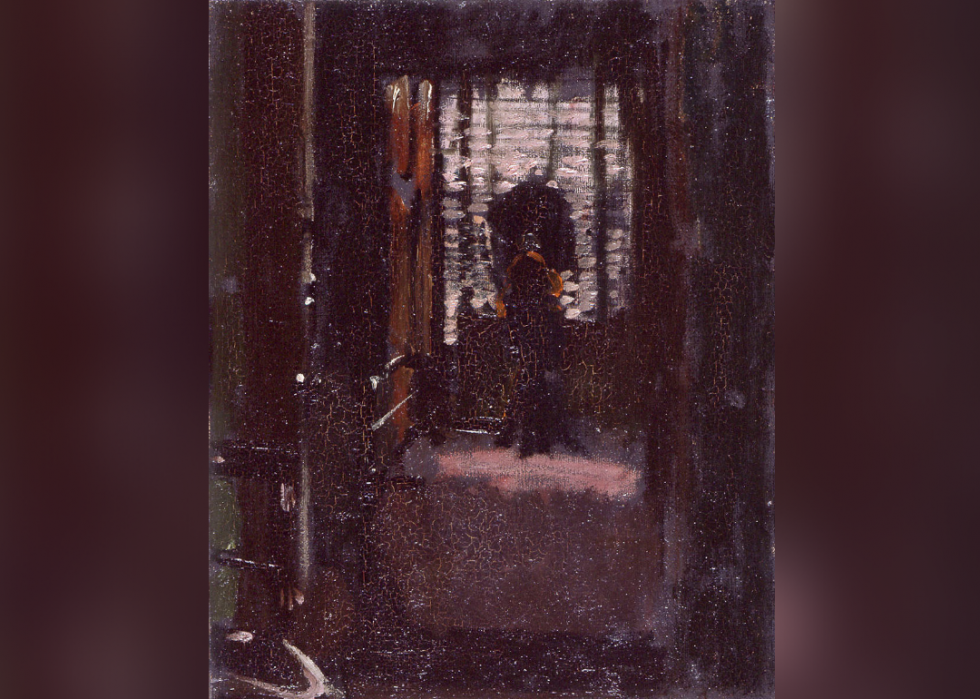
12 / 50
Public Domain // Wikimedia Commons
Jack the Ripper's Bedroom
- Artist: Walter Sickert
- Yr: 1908
Walter Sickert, noted for his moody portraits and dimly lit domestic interiors, may take harbored a hole-and-corner darker than his paintings. It has been argued that disconcerting works such equally "Jack the Ripper's Bedroom" and "The Camden Town Murder" may reflect some connection between the artist and the grisly Whitechapel butcher—either as an accomplice or the murderer himself.
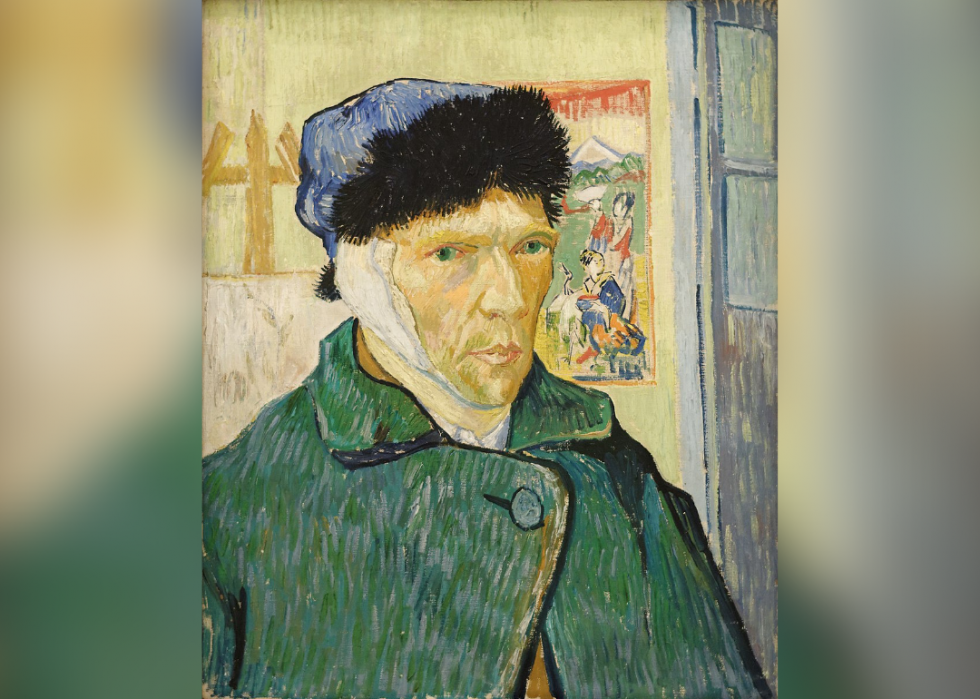
thirteen / 50
Public Domain // Wikimedia Commons
Self-Portrait with Bandaged Ear
- Artist: Vincent van Gogh
- Twelvemonth: 1889
Vincent van Gogh is famous for having severed his own ear; the strained relationship with beau mail service-impressionist Paul Gauguin that precipitated the creative person's cocky-mutilation is not nearly as well known. Van Gogh spent 1888 working in the South of France and was joined in October of that year by Gauguin. Their friendship deteriorated, and van Gogh didn't react well to the news of Gauguin's impending departure. The troubled artist cut off his ear, wrapped in newspaper, and reportedly gave it to a local prostitute for safekeeping. "Cocky-Portrait with Bandaged Ear" depicts van Gogh in his studio, with the right side of his head wrapped in fabric. In fact, it was a portion of van Gogh's left ear that was removed, with the inconsistency in the painting arising from the inverted reflection perceived past the artist while gazing in the mirror.
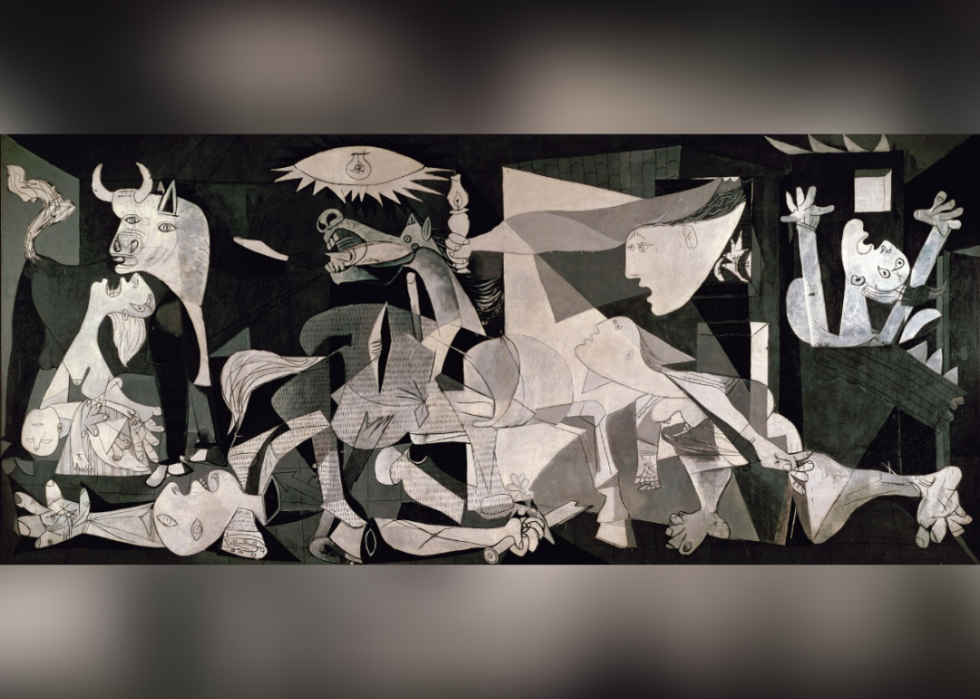
xiv / 50
Laura Estefania Lopez // Wikimedia Commons
Guernica
- Creative person: Pablo Picasso
- Year: 1937
An enormous, shifting mass of distorted, agonized figures, Pablo Picasso's "Guernica" was the artist's personal response to the horrific bombing inflicted past the Germans on the tiny Basque town in 1937. Exhibited at the Exposition Internationale des Arts et Techniques dans la Vie Moderne the same year, the painting was a plea for peace in an age of brutal conflict—both the Spanish Civil War and the dawn of World War II. Picasso expressly forbid the exhibition of his masterwork in Espana until the country became a commonwealth. While his homeland never met that demand, the painting was seen—behind bullet-proof glass—at the Prada in Madrid in 1981, half dozen years after the death of dictator Francisco Franco.
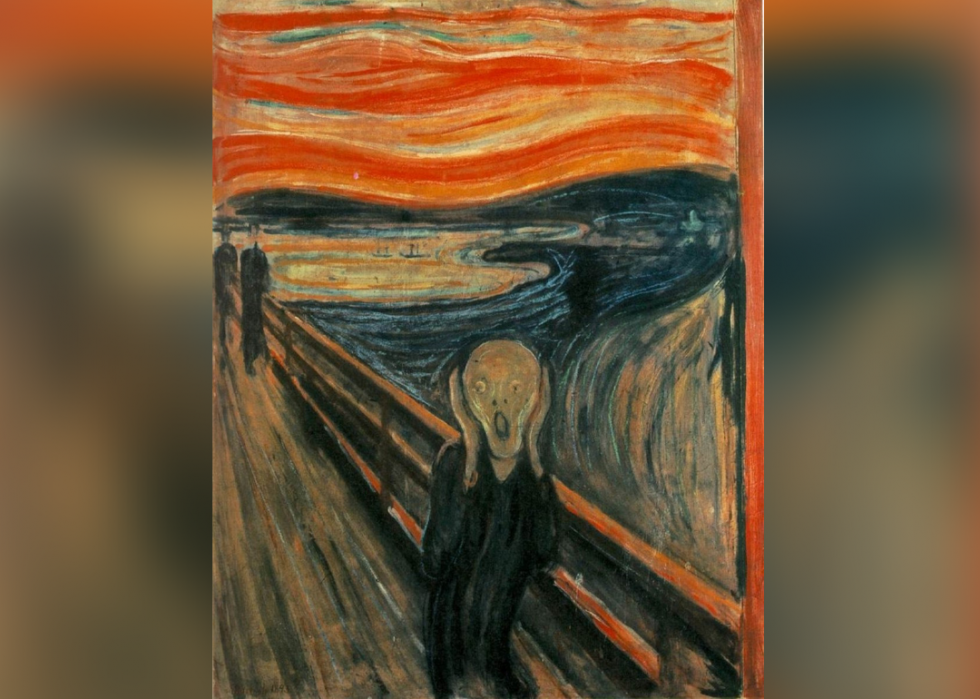
15 / 50
Public Domain // Wikimedia Eatables
The Scream
- Artist: Edvard Munch
- Twelvemonth: 1893
Popularly known as "The Scream," Norwegian artist Edvard Munch's expressionist masterpiece is frequently interpreted every bit a primal response to the excessive pressures of mod life. Originally titled "The Shriek of Nature," the image was created with an entirely different intent, as related by Munch himself, "One evening I was walking forth a path, the city was on one side and the fjord below. I felt tired and ill. I stopped and looked out over the fjord—the sun was setting, and the clouds turning blood red. I sensed a scream passing through nature; it seemed to me that I heard the scream. I painted this picture, painted the clouds as actual blood. The colour shrieked." The iconic painting was stolen from the Oslo National Gallery in 1994; the culprit was apprehended and the painting recovered several months later. Ironically, a 1910 version of "The Scream" was taken in broad daylight from the Munch Museum in 2004. Information technology, besides, was eventually recovered despite fears it had been destroyed.
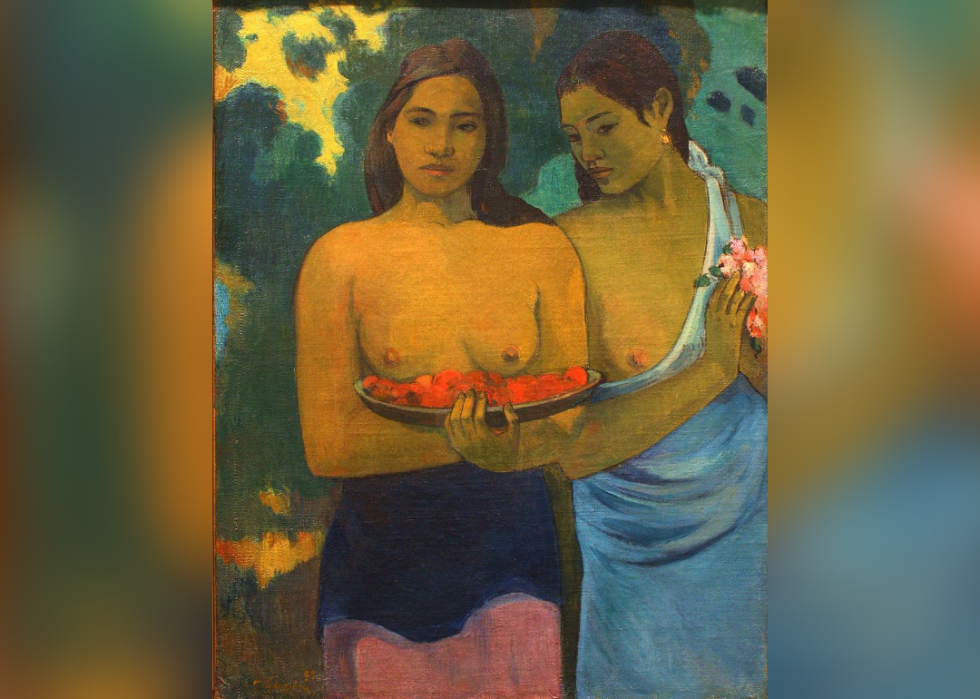
sixteen / 50
Postdif // Wikimedia Commons
Two Tahitian Women
- Artist: Paul Gauguin
- Year: 1899
A leading post-impressionist and frenemy of Vincent van Gogh, Gauguin abased his married woman and children for a hedonistic life in the Southward Seas. Admired for over a century for his seemingly innocent portraits of Tahitian women, Gaughin was too a syphilitic sexual predator who molested countless young girls in his Polynesian pleasure palace dubbed "The Business firm of Orgasm."
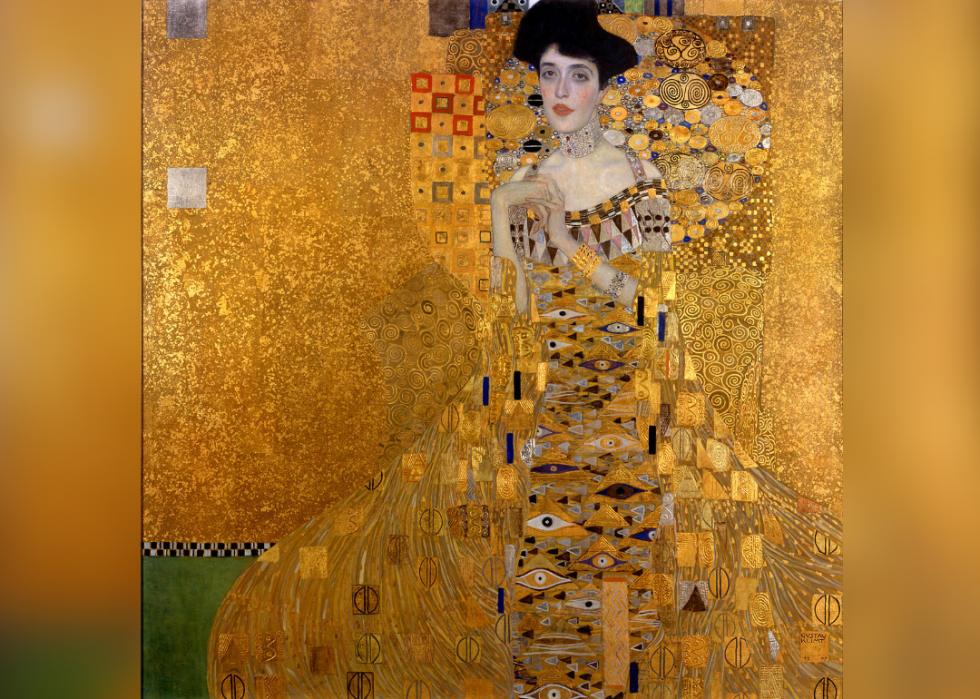
17 / 50
Public Domain // Wikimedia Commons
Portrait of Adele Bloch-Bauer
- Artist: Gustav Klimt
- Year: 1907
One of a handful of paintings seized by the Nazis from the family home of Ferdinand Bloch-Bauer, this glittering portrait by fin-de-siecle creative person Gustav Klimt depicts the Viennese sugar magnate's married woman—art enthusiast and club hostess Adele Bloch-Bauer. After the state of war, the portrait turned upwards in the land-run Galerie Belvedere. Maria Altmann, Adele's niece, spent years fighting for the painting's return, finally triumphing in 2006. The incredible story was made into a pic, "Woman in Aureate," starring Helen Mirren every bit Altmann. Both patron and muse, Bloch-Bauer is the just sitter Klimt painted twice.
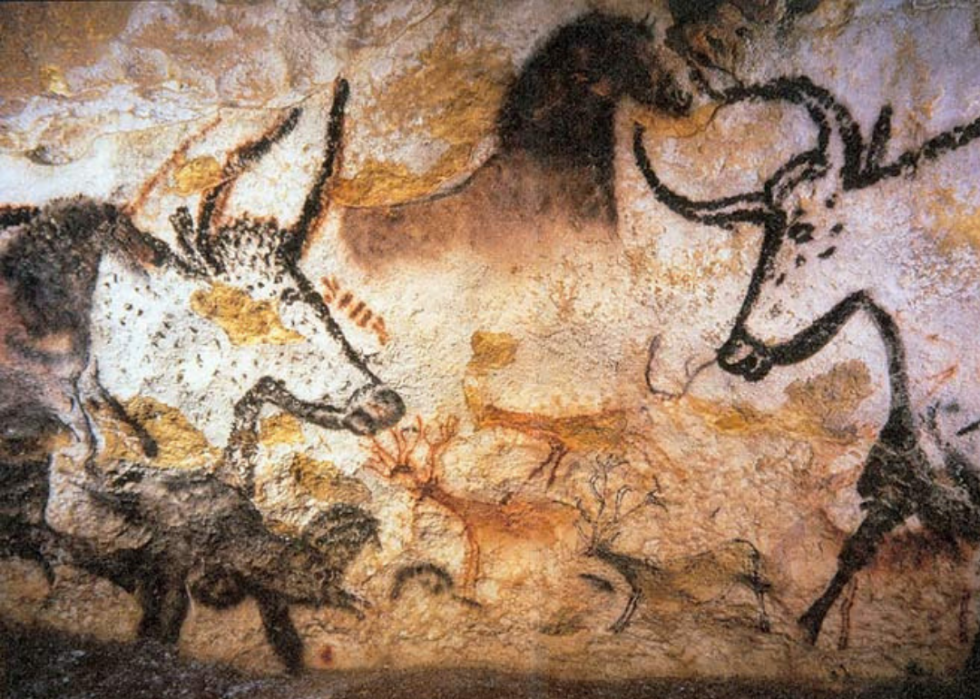
xviii / 50
Prof saxx // Wikimedia Eatables
Lascaux Cave Paintings
- Creative person: Unknown
- Year: c. 15,000–17,000 B.C.
In 1940, eighteen-yr-old Marcel Ravidat opened a window to the afar past when he cruel into a hole while out walking with his dog in the Dordogne region of France. The hole led to a cave covered with approximately half-dozen,000 Paleolithic images depicting animals, enigmatic symbols, and a solitary human form. The purpose of the paintings, created with mineral pigments and charcoal, is obscure merely may be linked to some sort of ceremonial rite.
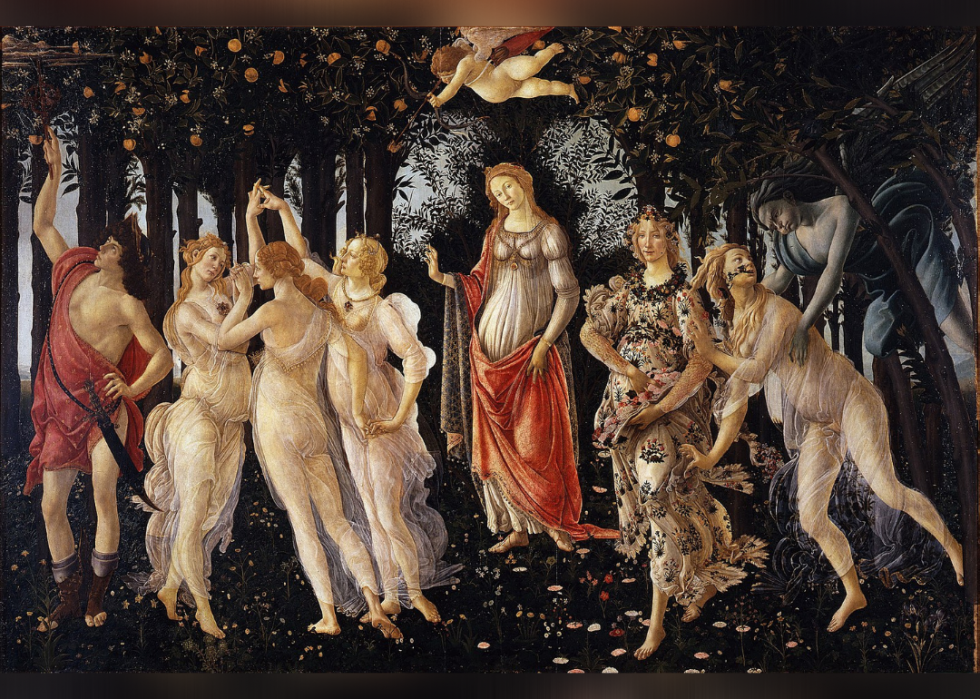
xix / 50
Public Domain // Wikimedia Commons
Primavera
- Artist: Sandro Botticelli
- Yr: 1477–1482
Christened "Primavera" by pioneering art historian Giorgio Vasari in 1550, Boticelli's mysterious masterwork originally lacked a championship. Although its precise meaning remains enigmatic, "Primavera" is an allegorical work inspired by classical mythology, depicting the transformation of the nymph Chloris into Flora, the goddess of spring. Commissioned by a member of the powerful Medici clan, information technology has been suggested that figures in the composition were modeled on members of the family.
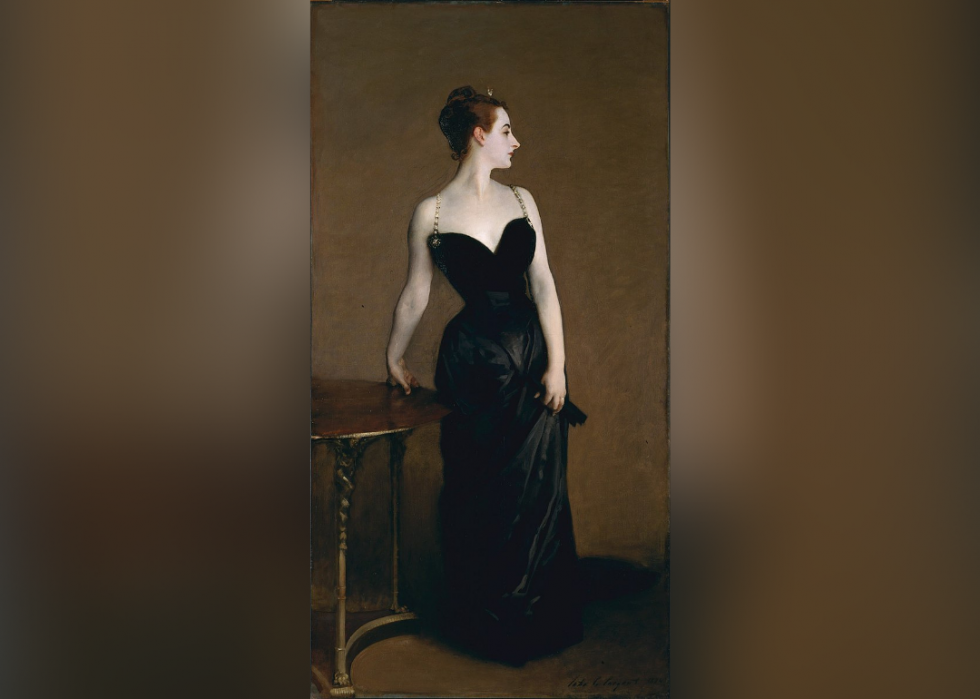
twenty / 50
Public Domain // Wikimedia Eatables
Portrait of Madame 10
- Creative person: John Singer Sargent
- Twelvemonth: 1883–84
John Singer Sargent's moody portrait of Virginie Avegno Gautreau, the American wife of a French banker, outraged critics when it was offset exhibited at the Paris Salon 1884. Sargent had hoped the portrait would make his career. The painting, nevertheless, fix off a scandal of such magnitude that Sargent exiled himself to England. What was it that had and so offended Parisian high society? While the paradigm's overt sexuality was expected for a mythological heroine and tolerable for a prostitute moonlighting equally an artist's model, it was downright threatening when applied to a adult female of their own cast.
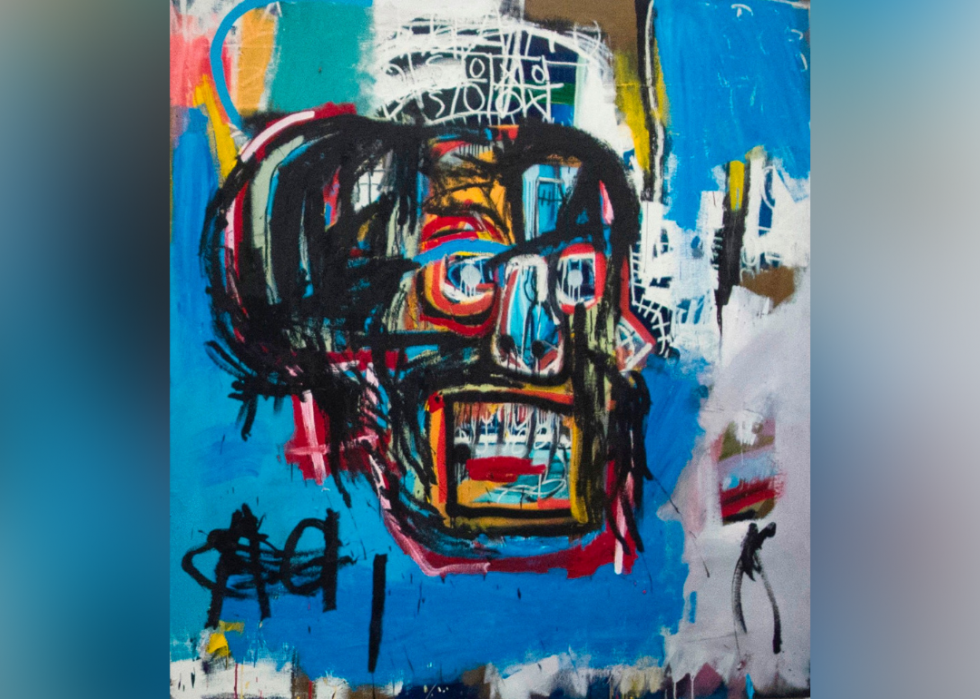
21 / fifty
Don Emmert // Getty Images
Untitled
- Artist: Jean-Michel Basquiat
- Year: 1982
Jean-Michel Basquiat's meteoric rise from Brooklyn graffiti artist to critically acclaimed painter is the stuff of legend. The youthful Neo-expressionist lived difficult and died at the tender age of 27 from a heroin overdose. In Dec 2018, 1 of Basquiat's untitled works set up a record at Sotheby'southward, selling for a $110.5 million. The staggering selling price spurred the possessor of another Basquiat painting to take the work authenticated. An ultraviolet light exam revealed that the painting included elements drawn by Basquiat in invisible ink.
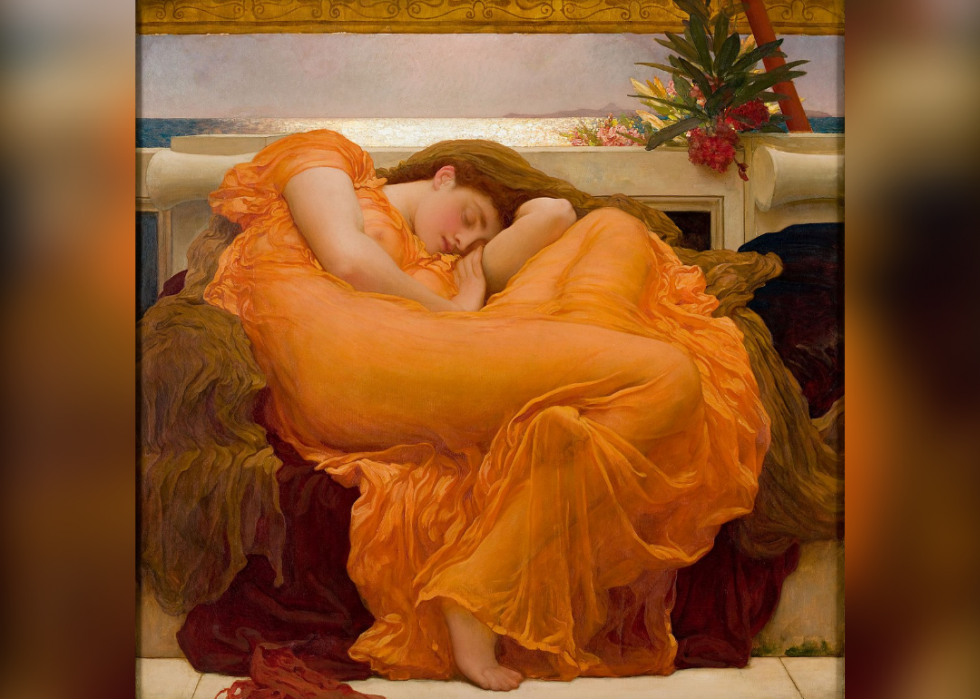
22 / 50
Public Domain // Wikimedia Commons
Flaming June
- Artist: Sir Frederic Leighton
- Year: 1895
"Flaming June," of the languid beauty in the transparent orange dress, was painted by esteemed British creative person Frederic Leighton at the shut of the 19th century. The painting disappeared soon afterwards, only to reemerge in the early 1960s when information technology was supposedly discovered in a chimney by a laborer working at a construction site. Considered highly unfashionable at the time, the painting failed to make reserve when it came to auction. Information technology was acquired soon after by Puerto Rico's Museo de Arte de Ponce, where it remains to this day.
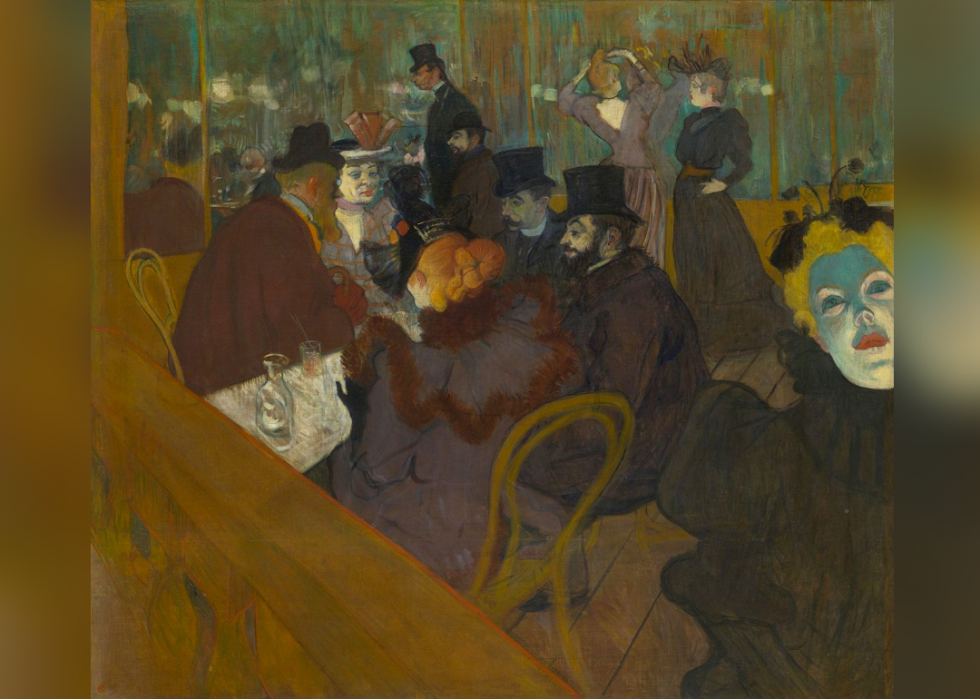
23 / 50
Public Domain // Wikimedia Commons
At the Moulin Rouge
- Artist: Henri de Toulouse-Lautrec
- Year: 1892–95
Born to wealth and privilege, Toulouse-Lautrec abandoned his aristocratic roots in favor of the working-grade Montmartre district and its colorful nightlife. The artist appears to have been afflicted with a genetic disorder affecting growth and bone development; he walked with a cane and reached an adult height of just 4 anxiety, 8 inches tall. Taunted for his physical appearance, he self-medicated with booze, notably absinthe. "At the Moulin Rouge" depicts the world in which Toulouse-Lautrec felt most at ease. In addition to entertainers such equally red-headed chanteuse Jane Avril and dancer May Milton (with the verdigris-tinted complexion), the piece also includes a self-portrait of the artist in the company of his cousin, Gabriel Tapié de Céleyran.
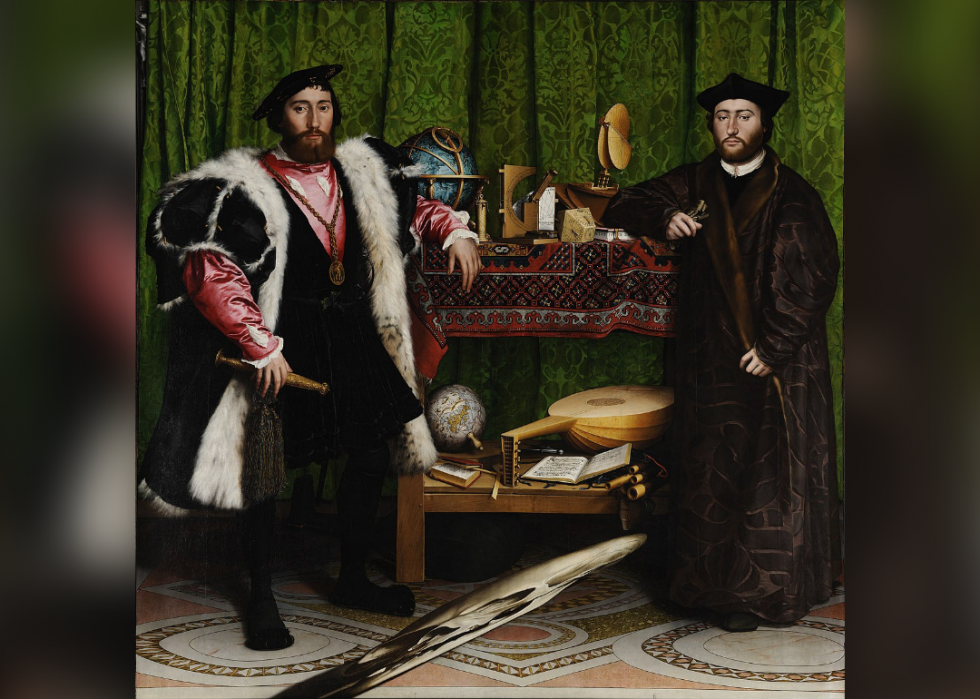
24 / l
Public Domain // Wikimedia Eatables
The Ambassadors
- Creative person: Hans Holbein the Younger
- Yr: 1533
The about in-demand portrait painter of his era, Hans Holbein spent a considerable amount of time at the courtroom of Henry VIII. "The Ambassadors" depicts Jean de Dinteville, the French ambassador to England, and his friend, George de Selve, both in their belatedly 20s; de Selve, the bishop of Lavaur, served as ambassador to both the Holy Roman emperor and the pope.
The painting is scattered with emblematic components, including a lute with broken strings—perchance symbolic of Henry VIII's suspension with Rome so that he could divorce Catherine of Aragon and marry his mistress, Anne Boleyn. The blurry, black-and-white object that bisects the bottom of the composition is, in fact, a human being skull, representing bloodshed. Striking use of anamorphosis, it can but be viewed from an astute angle, forcing observers to view the painting from a variety of perspectives.
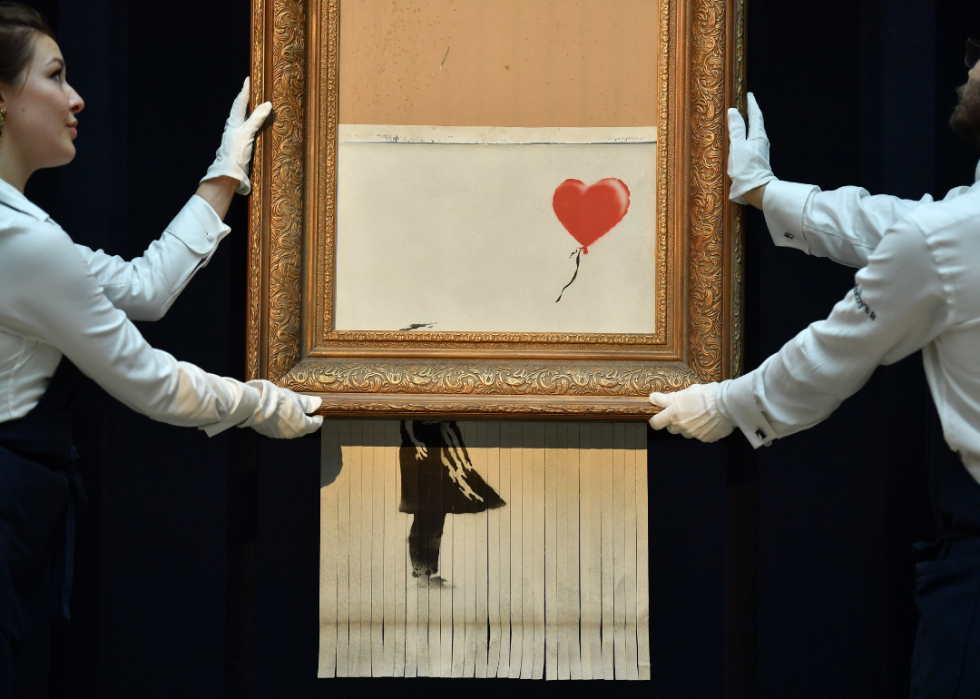
25 / l
Ben Stansall // Getty Images
Girl With Balloon
- Artist: Banksy
- Twelvemonth: 2006
In 2002, the stenciled image of a girl reaching toward a crimson, center-shaped balloon appeared on a staircase leading to London'due south Waterloo Bridge. Attributed to the elusive creative person Banksy, several other examples popped up around London in subsequent years. In 2018, a 2006 version of the painting was auctioned at Sotheby's for the princely sum of $1.4 million, automatically shredding itself by ways of a device subconscious past the artist inside the frame the moment the gavel hit the block. Moments subsequently the incident, Banksy posted an Instagram video depicting telephone staff staring in shock at the mutilated work.
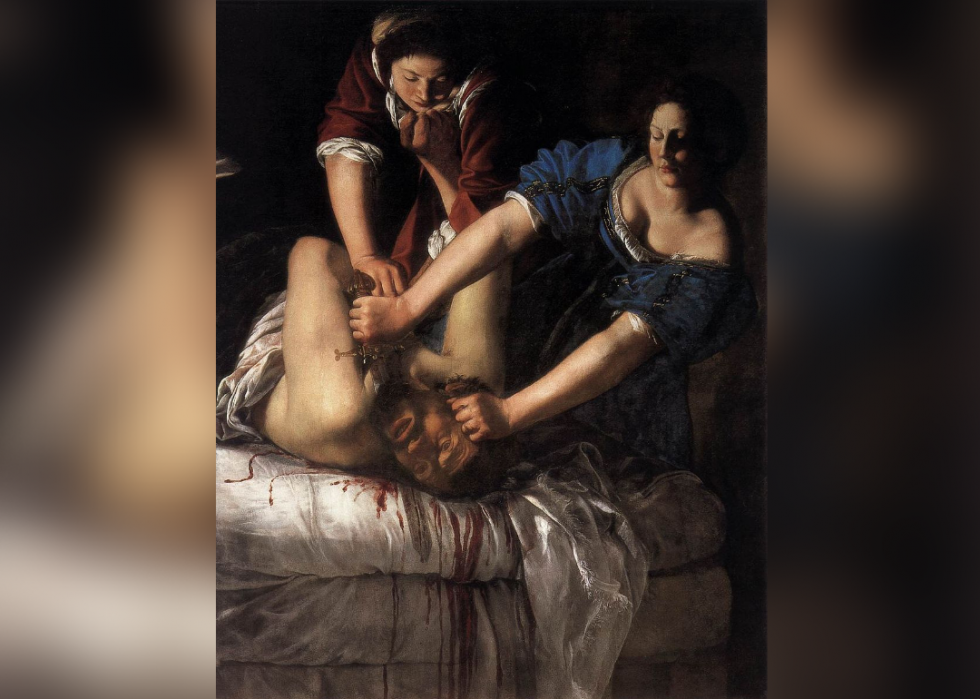
26 / 50
Public Domain // Wikimedia Commons
Judith Slaying Holofernes
- Artist: Artemisia Gentileschi
- Twelvemonth: 1610
Historically, it hasn't been easy for women artists to break into the big time, just Baroque painter Artemisia Gentileschi did but that, exercising her demons in the process. Sexually assaulted at eighteen, Gentileschi angrily confronted her assailant in a public trial which ultimately set him costless. She channeled her ensuing rage into her work, notably "Judith Slaying Holofernes," which depicts determined Former Testament heroine Judith severing the head of the drunken Babylonian general.
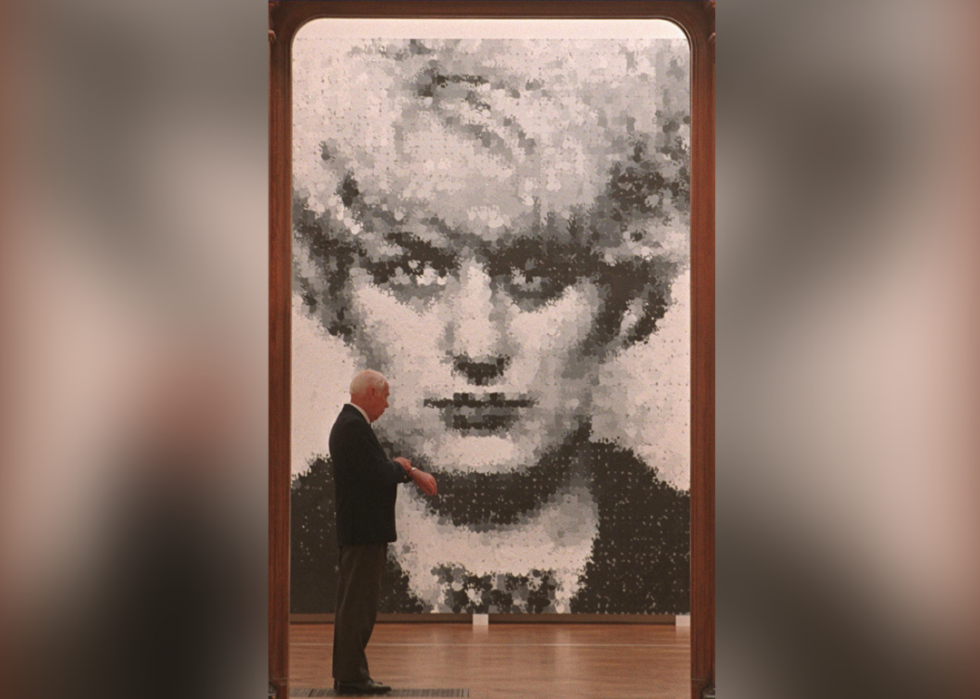
27 / 50
Paul Vicente // Getty Images
Myra
- Artist: Marcus Harvey
- Year: 1995
When Marcus Harvey's massive painting of U.k.'s nearly despised woman—'60s child killer Myra Hindley—debuted at the 1997 Sensation exhibition at London'due south Royal Academy of Arts, to say information technology was met with controversy would be an understatement. Four members of the Academy resigned in protest and the painting was vandalized repeatedly.
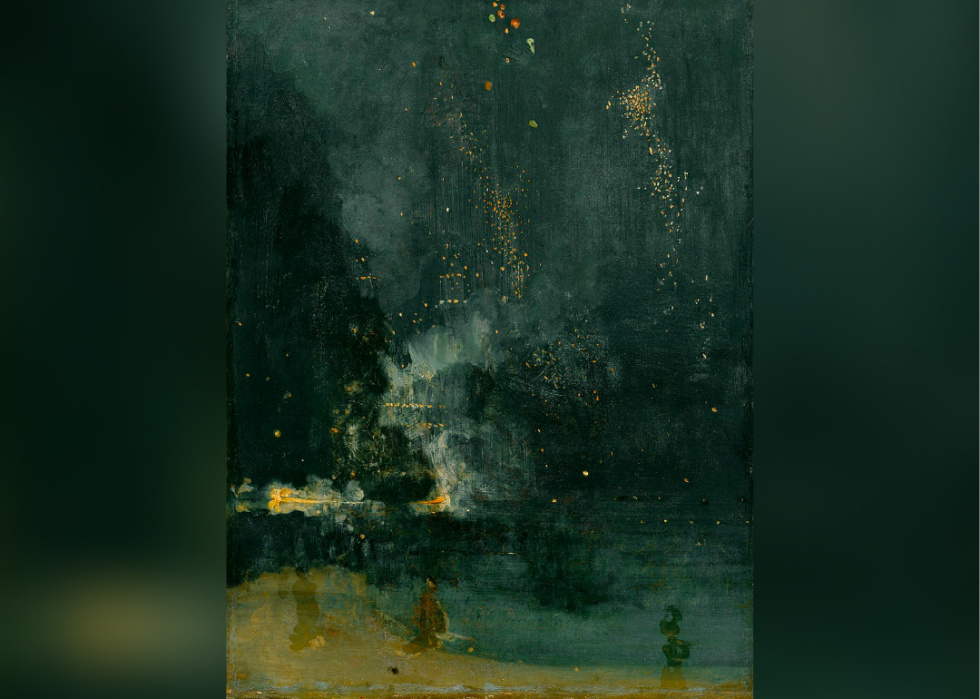
28 / 50
Public Domain // Wikimedia Commons
Nocturne in Black and Gold, the Falling Rocket
- Artist: James Abbott McNeill Whistler
- Year: 1875
What could be and so objectionable near a painting of fireworks over a picturesque London park? Quite a lot, evidently. Whistler, a proponent of the artful motility, failed to impress revered Victorian art critic John Ruskin, with his series of paintings referred to equally his "nocturnes." Ruskin savaged Whistler's work—as well as the painting's hefty asking toll of 200 guineas (a guinea was a money equal to virtually one-quarter ounce of gold, minted between 1663–1814 in Great Great britain). Whistler retaliated by taking Ruskin to court, suing him for libel. Whistler emerged triumphant just the ordeal bankrupt both men, bankrupting Whistler and causing Ruskin to resign his Oxford professorship.
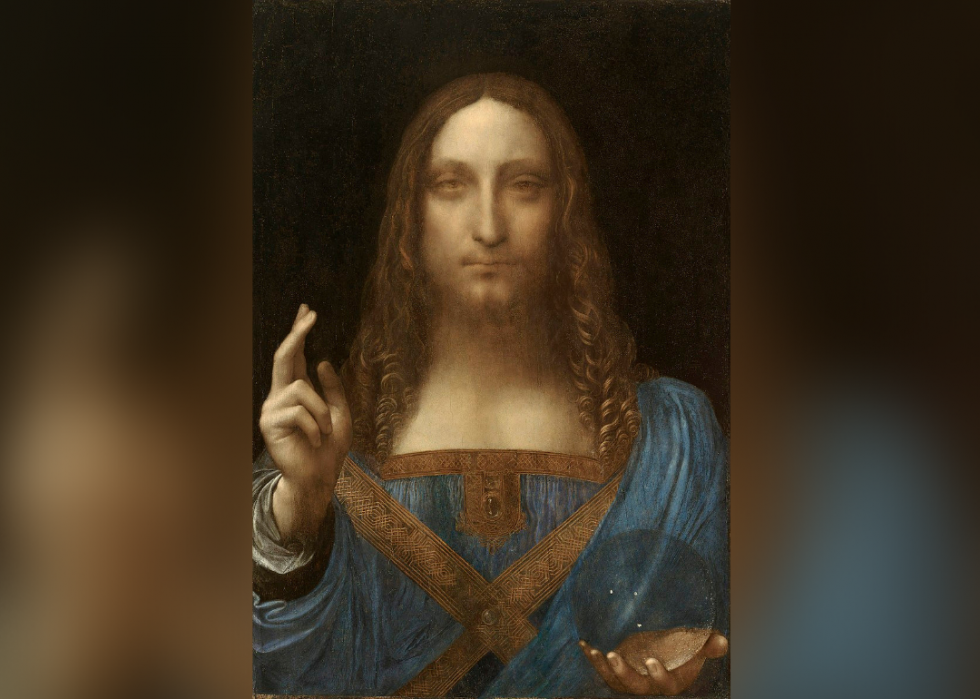
29 / 50
Public Domain // Wikimedia Commons
Salvator Mundi
- Artist: Leonardo da Vinci
- Year: 1500
Believed for years to exist the product of his atelier, or even a re-create of a lost work past the Renaissance master, "Salvator Mundi" sold at auction in Nov 2017 for a cool $450.3 one thousand thousand later scholars reached a consensus that the painting was the piece of work of da Vinci. Idea to be bound for the Louvre Abu Dhabi, the small-scale console disappeared from public view immediately after auction at Christie's. It is believed to be in the possession of a Saudi prince (possibly Mohammed bin Salman Al Saud), either locked away in a Swiss bank vault, or displayed on a luxury yacht somewhere on the high seas.
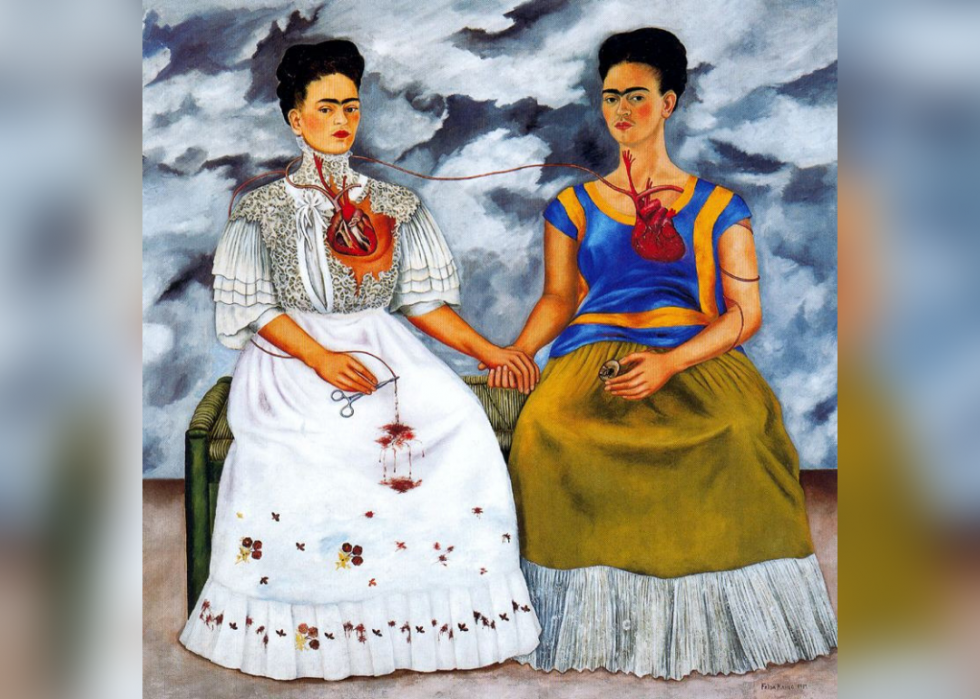
30 / 50
The Two Fridas
- Artist: Frida Kahlo
- Twelvemonth: 1939
Mexican artist Frida Kahlo has developed an almost cult-like following in contempo years, but took a back seat to hubby and fellow-artist Diego Rivera during her lifetime. Kahlo's work is infused with a deeply personal iconography and references a life of physical and emotional anguish. "The Two Fridas," portrays the artist before and afterwards her painful separation from Rivera; on the left as a bride with an eviscerated heart, and on the correct dressed in the traditional Mexican costume she favored during happier times with Rivera.
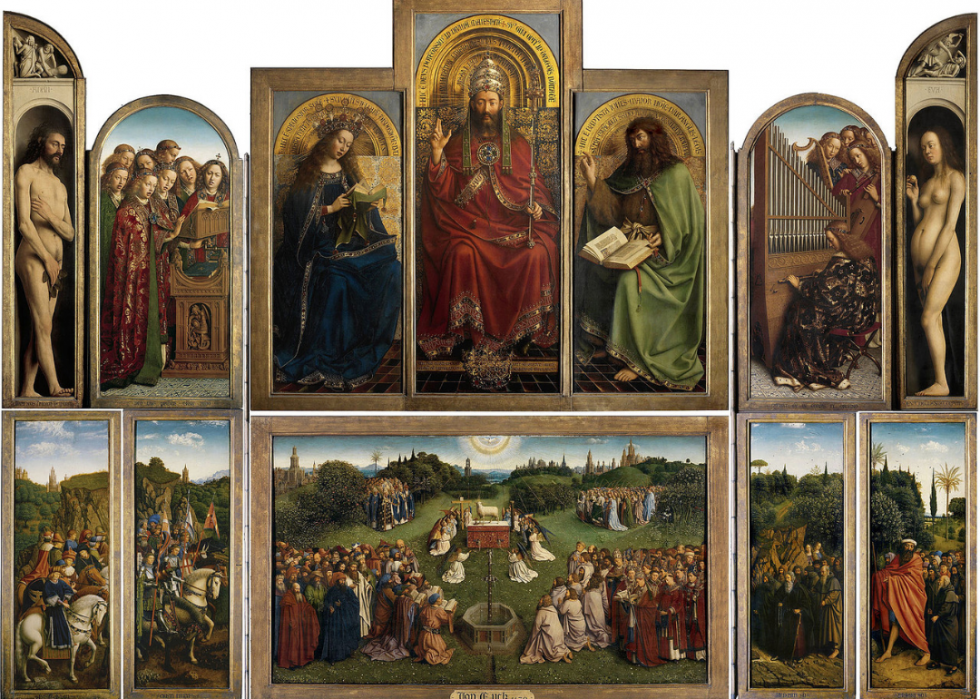
31 / 50
Public Domain // Wikimedia Commons
The Ghent Altarpiece
- Artist: Hubert and January van Eyck
- Year: c. 1432
Fix aglow by Calvinists, hacked apart by avaricious dealers, and repeatedly stolen, "The Ghent Altarpiece" is arguably the most resilient painting in the history of art. Brothers Hubert and Jan van Eyck's Early Netherlandish polyptych, equanimous of 12 panels, was created for St. Bavo's Cathedral in Ghent, Belgium. In 1934, one of the smaller panels was stolen and never recovered. Several years afterwards, Hitler adult an interest in the painting and had it transported to Germany, where information technology was rescued from a salt mine by the military unit composed of art historians known as The Monuments Men.
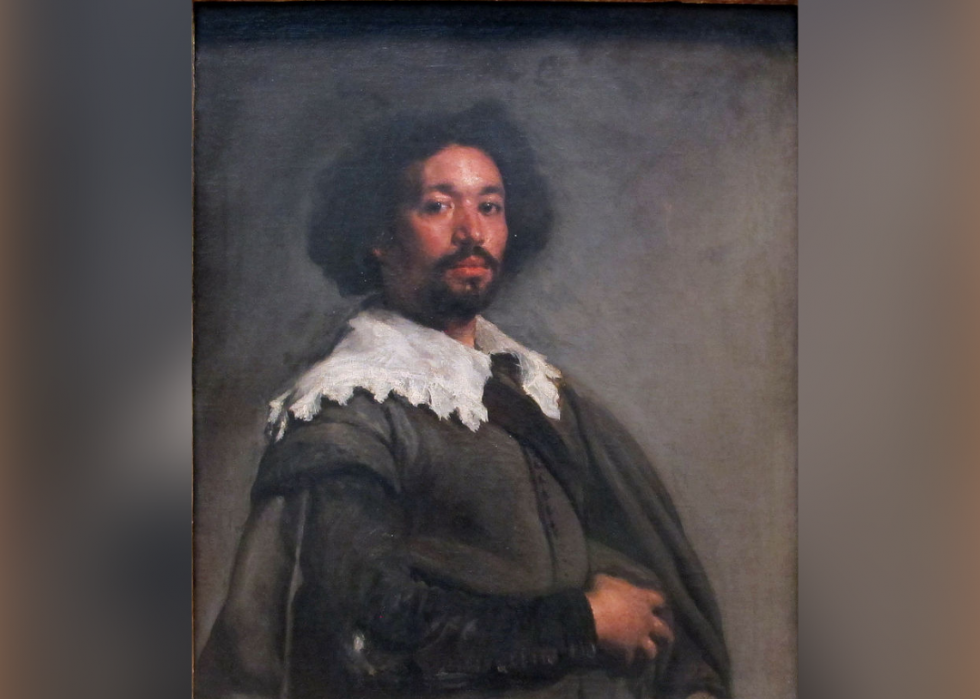
32 / fifty
Sailko // Wikimedia Commons
Juan de Pareja
- Creative person: Velázquez (Diego Rodríguez de Silva y Velázquez)
- Yr: 1650
A masterpiece of the Spanish Bizarre, Velázquez's introspective portrait of his atelier assistant, Juan de Pareja, was met with applause from contemporaries. An artist in his own correct, Pareja wasn't Velázquez's assistant by choice—he was the artist'due south slave. Shortly afterwards the painting was finished, Pareja was freed and went on to work as a painter in Madrid.
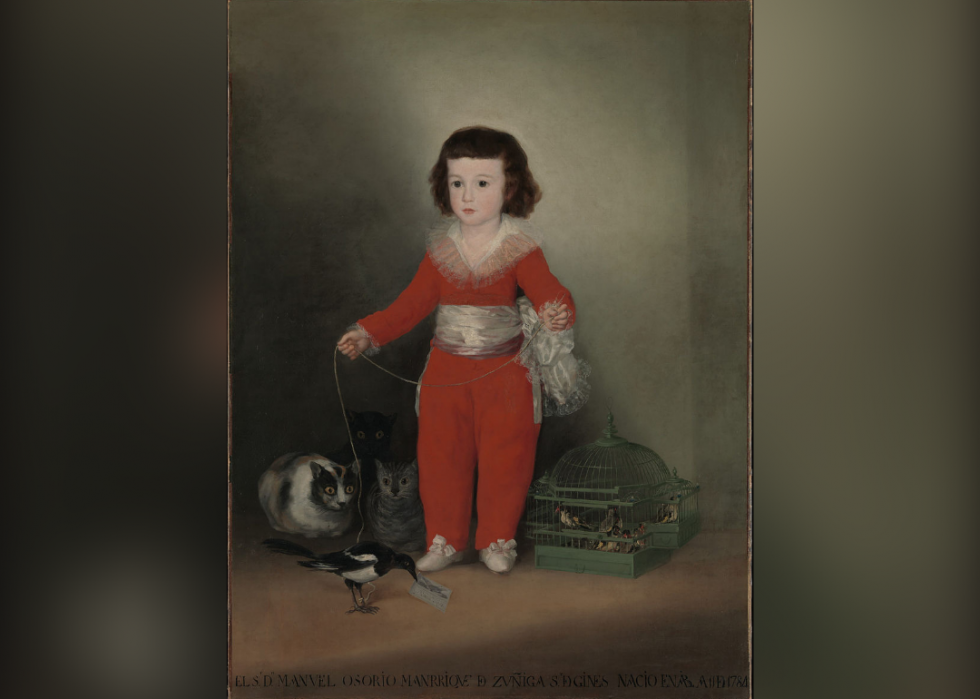
33 / fifty
Public Domain // Wikimedia Eatables
Manuel Osorio Manrique de Zuñiga
- Artist: Goya (Francisco de Goya y Lucientes)
- Year: 1787–88
Vicente Joaquín Osorio de Moscoso y Guzmán, count of Altamira, commissioned this tender portrait of his young son, Manuel, from court painter Francisco Goya. Dressed in a red silk romper with white cuffs and neckband, the elaborately dressed child poses with a menagerie of family pets, including a magpie. The image immortalized the little male child who passed away just a few years after it was painted.
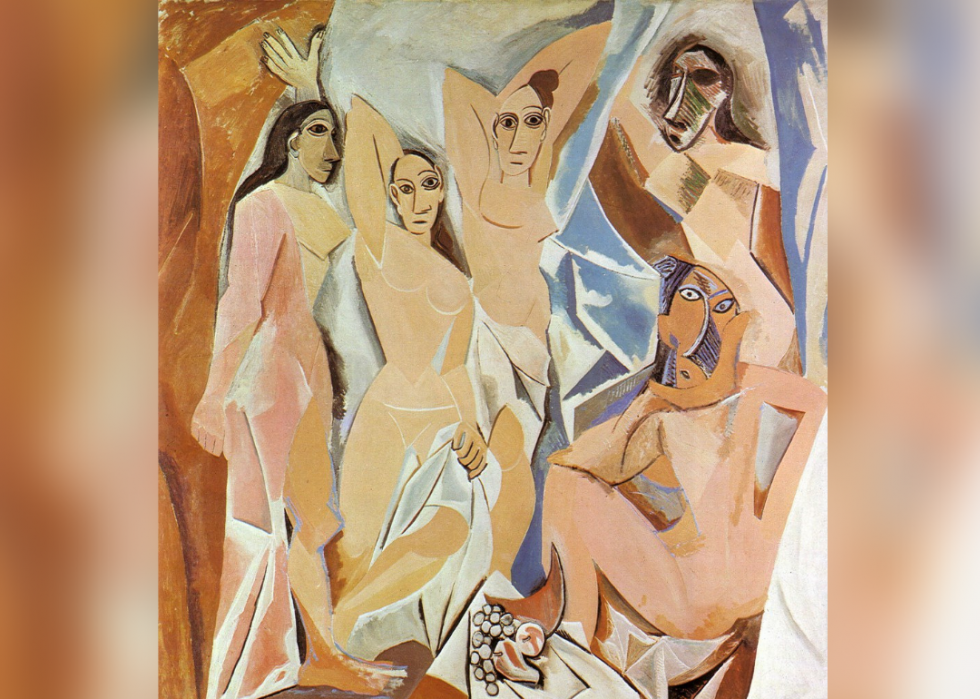
34 / l
Demoiselles d'Avignon
- Artist: Pablo Picasso
- Year: 1907
An icon of Cubism, Pablo Picasso's daring group portrait depicting an unabashed grouping of Spanish prostitutes was met with a tepid response from colleagues and critics alike. A riot of flat, geometric planes, Picasso drew inspiration both from African art and that of ancient Iberia.
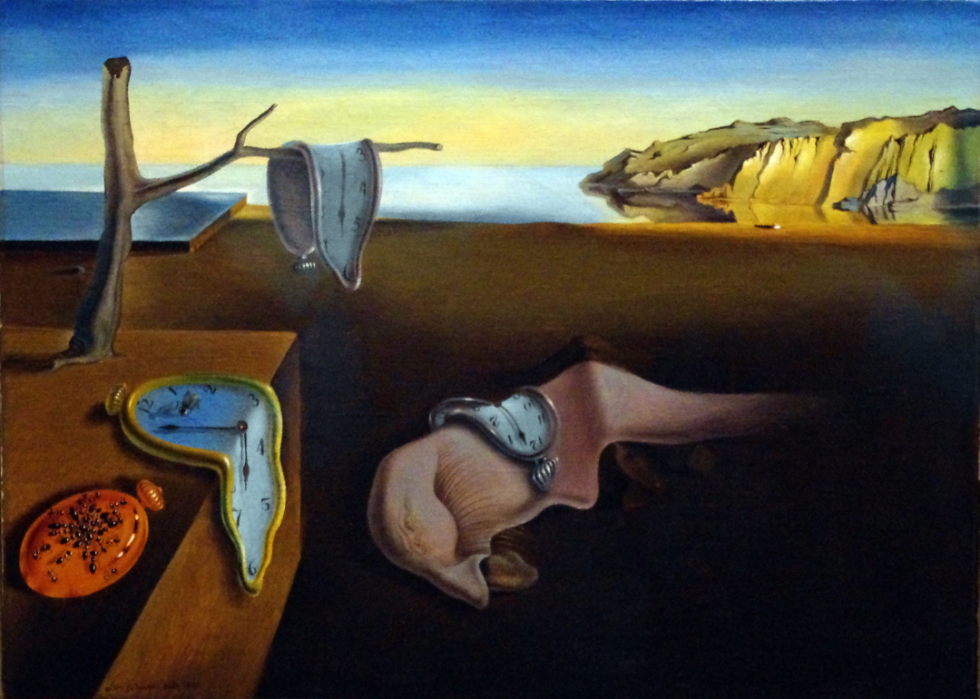
35 / 50
The Persistence of Memory
- Creative person: Salvador Dali
- Twelvemonth: 1931
Surrealist Salvador Dali subverts reality with this mesmerizing image of deflated timepieces scattered over a desert landscape. The composition defies logic, evoking a dream-like land. Dali employed the "paranoiac-critical method" in his artistic procedure, self-inducing a delusional land.
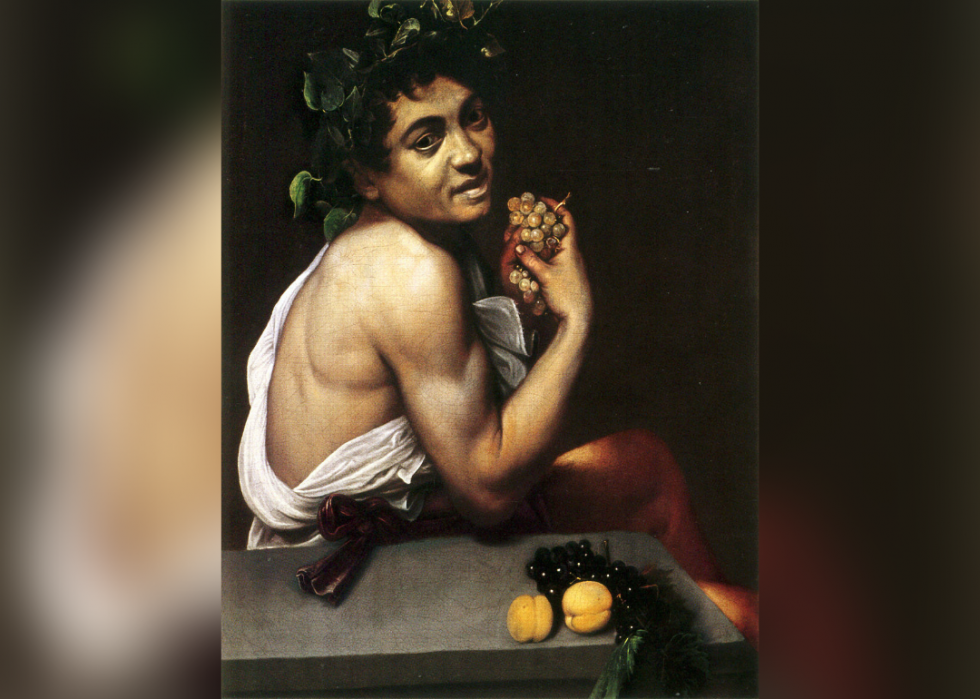
36 / l
Public Domain // Wikimedia Eatables
Young Sick Bacchus
- Artist: Caravaggio
- Yr: 1593
The God of Wine in Caravaggio's canvas has a distinctly greenish tinge, suggesting that he'south imbibed a flake too much of the fermented grape. A possible self-portrait, the unusual representation of the Roman deity may have been sparked by Carravagio's hospitalization for an unknown illness.
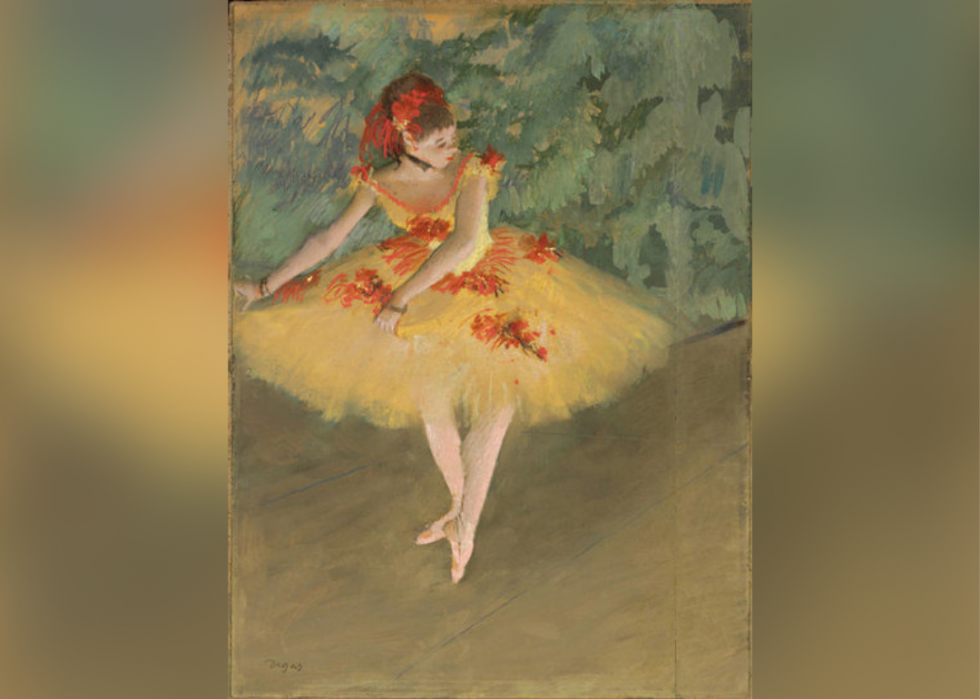
37 / 50
Public Domain // Wikimedia Commons
Dancer Making Points
- Creative person: Edgar Degas
- Yr: 1878–fourscore
Degas' "Dancer Making Points"—valued at $10 million—disappeared from reclusive copper heiress Huguette Clark'south Fifth Avenue home, inexplicably surfacing in New York's David Findlay Gallery soon after. The notoriously private Clark realized the painting was missing, but declined to report it to government. When it was revealed that Herbert Bloch of H&R Block fame had purchased information technology, a compromise was reached with Clark whereby the painting was donated to the Nelson-Atkins Museum of Art in Kansas Urban center.
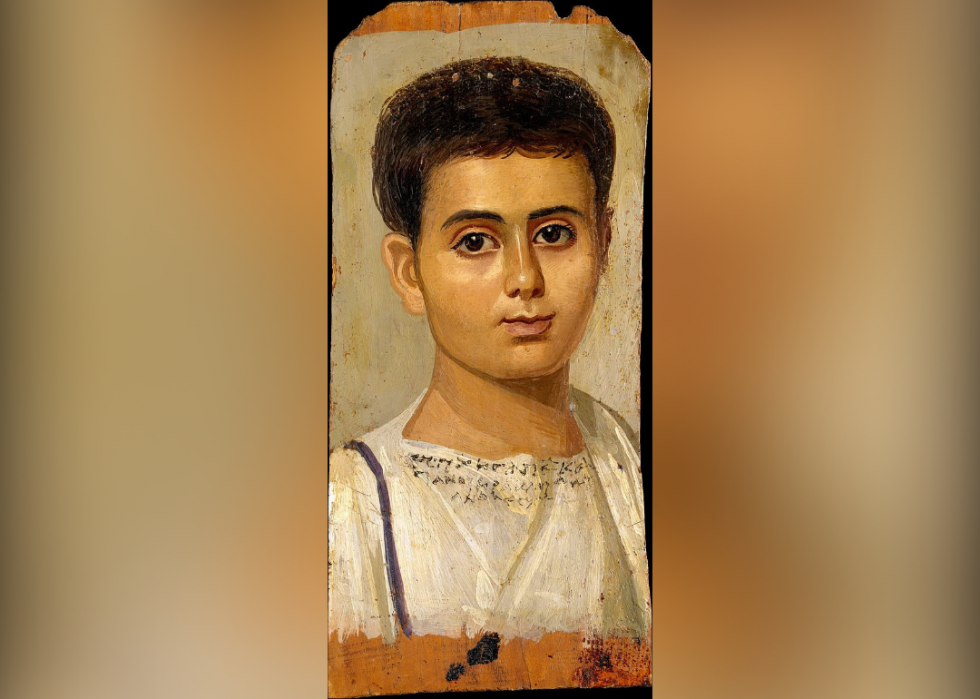
38 / l
Public Domain // Wikimedia Commons
Portrait of the Boy Eutyches
- Artist: Unknown
- Year: c. 100–150 A.D.
"Portrait of the Boy Eutyches" is just one of hundreds of remarkably life-like paintings produced in the ancient Egyptian Fayum region. Noted for their large, expressive eyes, these panels were painted with encaustics (hot wax tinted with pigments). Roman Egypt was a cultural melting pot, and the Fayum portraits reflect the cultural crossroads in which they were created. The encaustic procedure used by the Romans was adult by the ancient Greeks, and the resulting portraits were placed over the faces of the mummified dead—a distinctively Egyptian tradition.
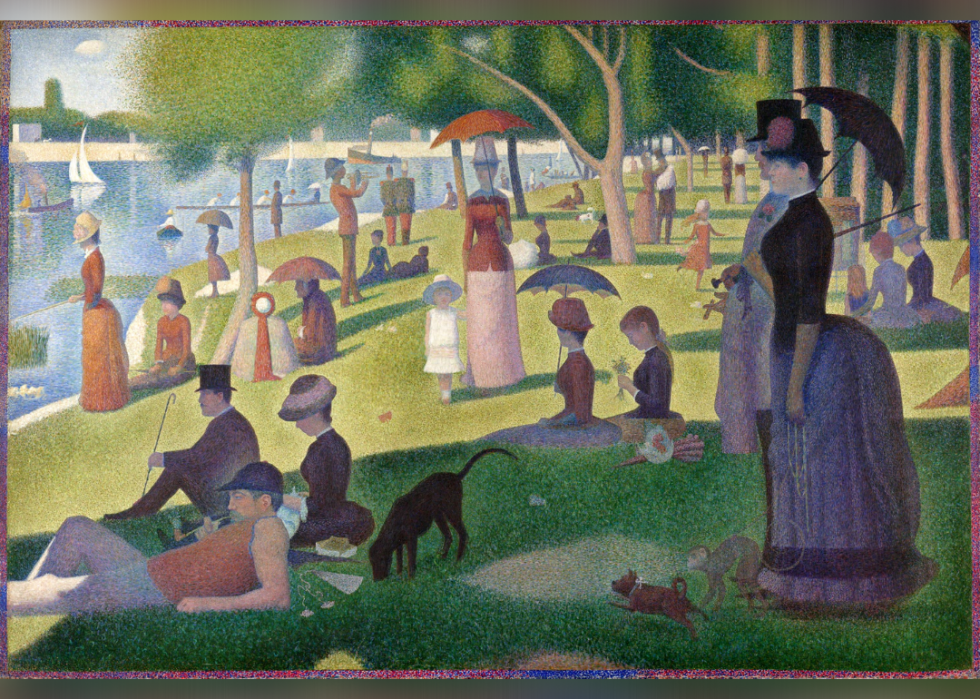
39 / l
Public Domain // Wikimedia Commons
A Sunday on La Grande Jatte
- Artist: Georges Seurat
- Twelvemonth: 1884
Information technology took Seurat ii years to finish his best-known work, pieced together from dozens of sketches the creative person made of working-course Parisians. Critics panned the seven-by-x-pes painting when it was get-go exhibited in 1886, dubious of the complicated theory of light and color underpinning Seurat's pioneering pointillism. Over the course of the next century, popular stance buoyed the painting to cult status, inspiring Stephen Sondheim to pen the hit Broadway musical "Sun in the Park with George."
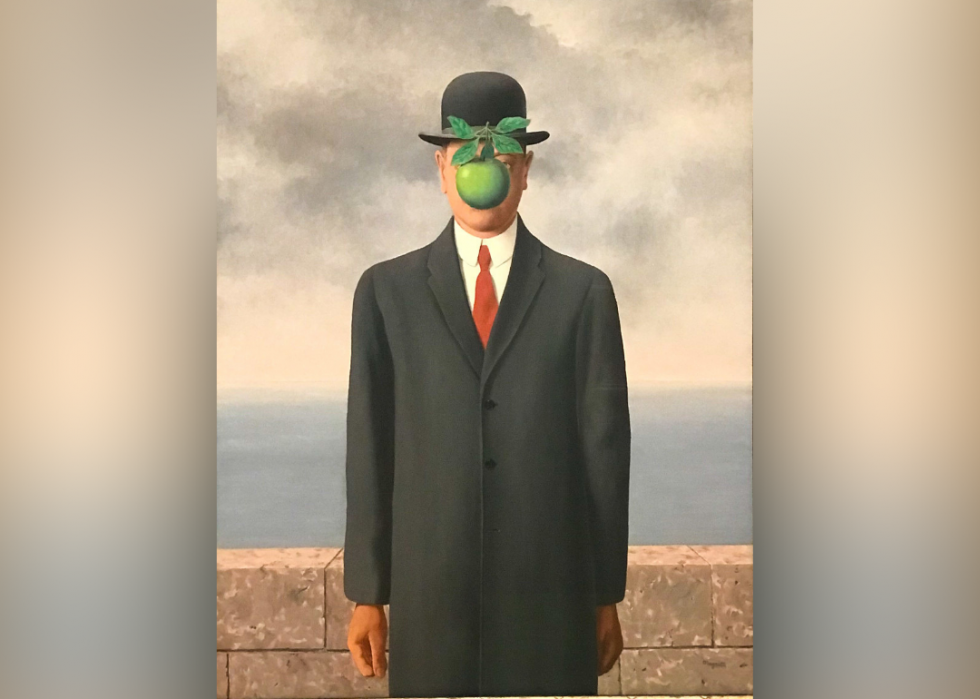
xl / 50
The Son of Man
- Creative person: René Magritte
- Yr: 1946
The works of the Belgian painter René Magritte are frequently head-scratchers, and "The Son of Man"—a cocky-portrait of the artist with his confront obscured by a giant apple tree—is no exception. The apple tree was one of the artist's favorite motifs, only its meaning is uncertain. The title chosen by Magritte is maybe more illuminating, referencing Jesus Christ. Some critics have called the piece a surrealist interpretation of the transfiguration of Jesus.
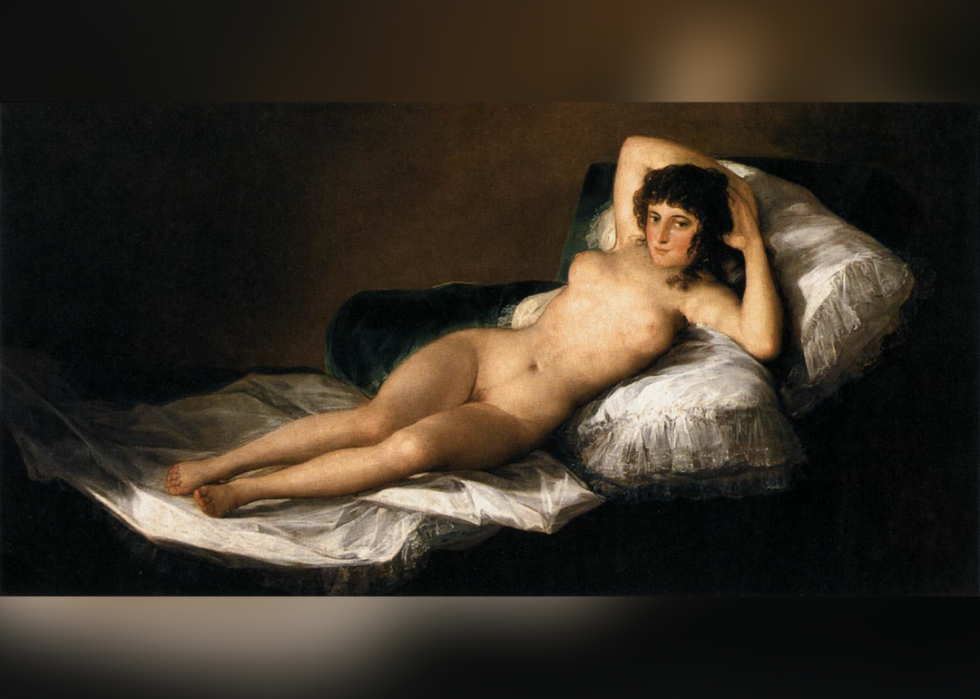
41 / l
Public Domain // Wikimedia Eatables
The Nude Maja
- Creative person: Francisco Goya
- Twelvemonth: 1797–1800
Goya painted two versions of the Maja—ane naked, the other fully clothed. The painting is believed to have been commissioned by Castilian Prime Minister Manuel de Godoy and was intended to supplement his existing collection of nudes. In 1814, the Inquisition confiscated the painting. Today, information technology hangs side by side to its companion in Madrid's Museo del Prado.
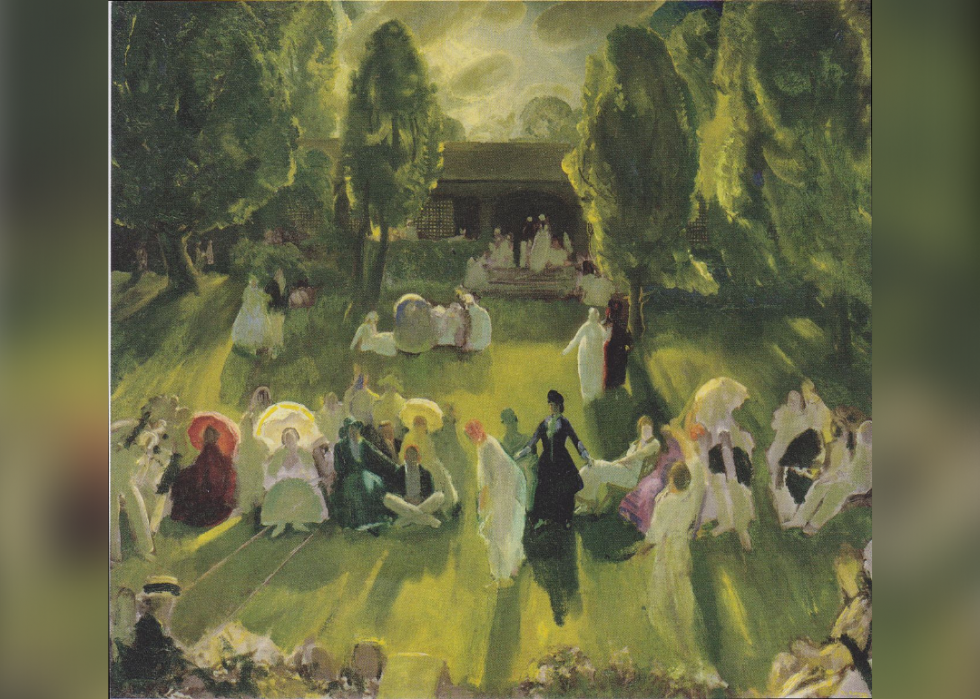
42 / 50
Public Domain // Wikimedia Eatables
Tennis at Newport
- Artist: George Bellows
- Yr: 1919
A departure from his gritty paintings of pugilists, George Bellows' "Tennis at Newport" depicts a tony tournament in Newport, Rhode Isle. Bathed in an otherworldly light, the painting focuses on the spectral images of the spectators, as opposed to the players. A member of the early 20th-century Ashcan School, American artist Bellows was instrumental in the organization of the greatly influential 1913 Armory testify in New York.
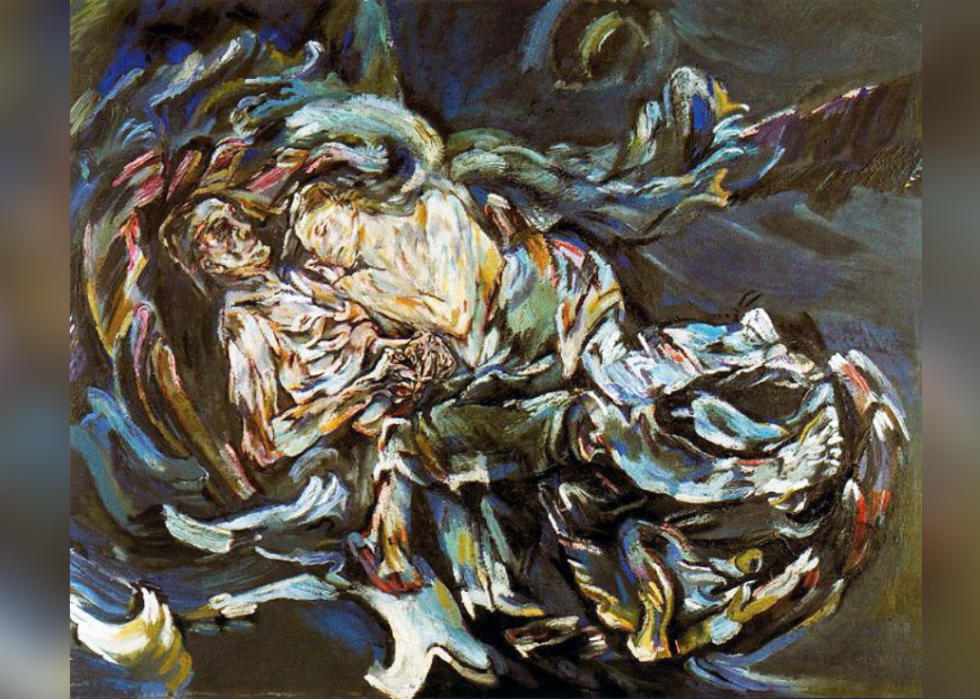
43 / fifty
Bride of the Wind
- Artist: Oskar Kokoschka
- Year: 1914
A beloved letter of the alphabet to his mistress, Oskar Kokoschka's most famous work depicts the artist entwined with his muse, Alma Mahler—the widow of composer Gustav Mahler. The celebrated expressionist was so dejected when Mahler ended their passionate matter, he deputed a life-size doll in her image.
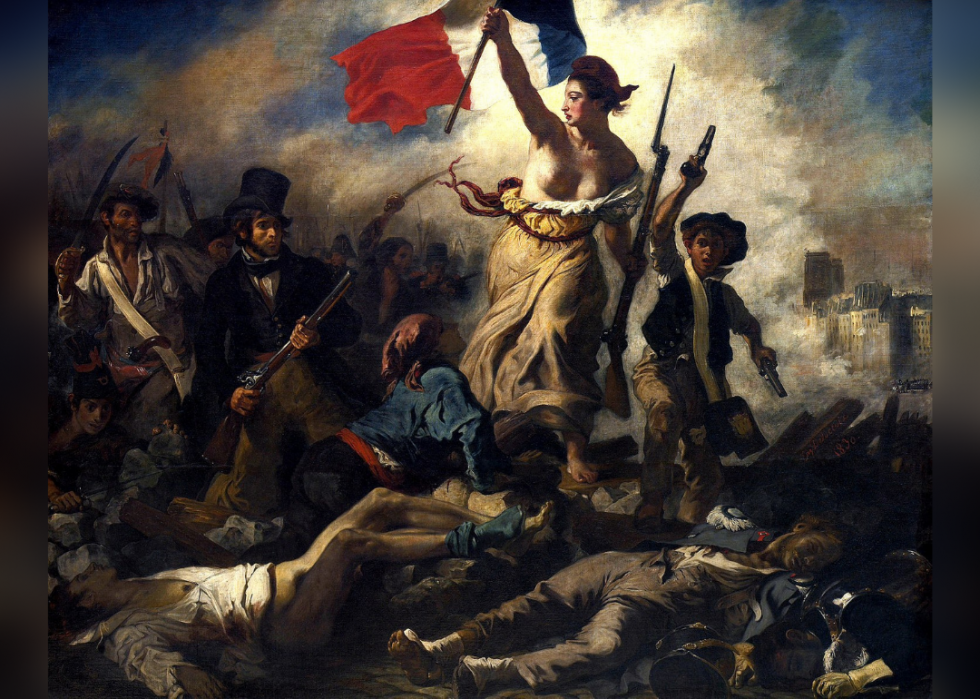
44 / 50
Public Domain // Wikimedia Eatables
Liberty Leading the People
- Artist: Eugène Delacroix
- Twelvemonth: 1830
While Delacroix'southward "Liberty Leading the People" may be familiar to modern viewers from the cover of Coldplay's 2008 release,"Viva la Vida," the exuberant sail was originally intended to celebrate the July Revolution of 1830. Dominating the composition is the central figure of a adult female holding the tricolor—considered to be the earliest known delineation of Marianne, the female personification of the Republic of France.
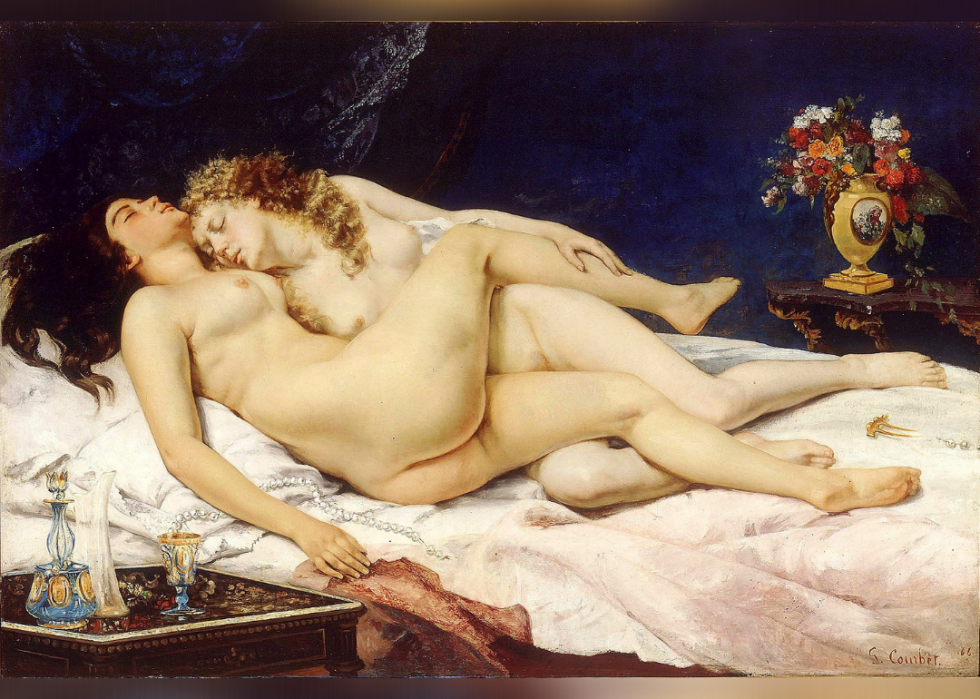
45 / 50
Public Domain // Wikimedia Commons
The Sleepers
- Artist: Gustave Courbet
- Yr: 1866
Painted for the Turkish diplomat Halil Şerif Pasha, Courbet's frankly erotic canvas sidestepped the Paris Salon, where it well-nigh certainly would have been met with condemnation. Pasha was an avid collector of Western paintings—notably those showcasing the female form—purchasing works by realists Delacroix and Ingres in addition to Courbet.
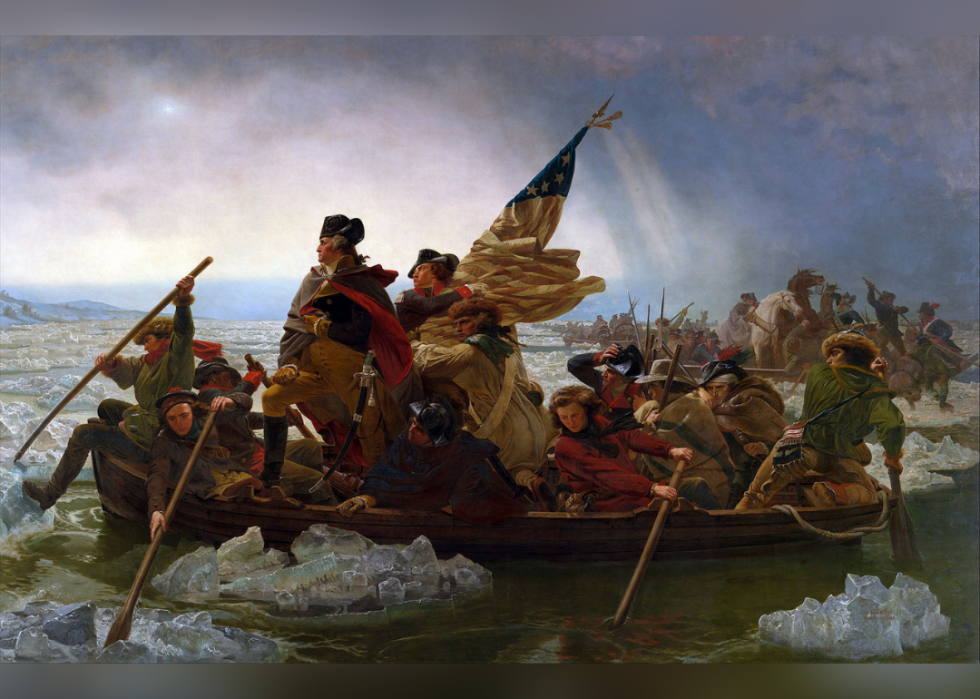
46 / fifty
Public Domain // Wikimedia Commons
Washington Crossing the Delaware
- Artist: Emanuel Leutze
- Twelvemonth: 1851
Not simply was the iconic "Washington Crossing the Delaware" painted almost 75 years afterward the Revolutionary War, but information technology was besides painted past German artist Emanuel Leutze in Düsseldorf. Leutze had spent time in the U.S. and painted the scene with the promise that it would inspire European revolutionaries.
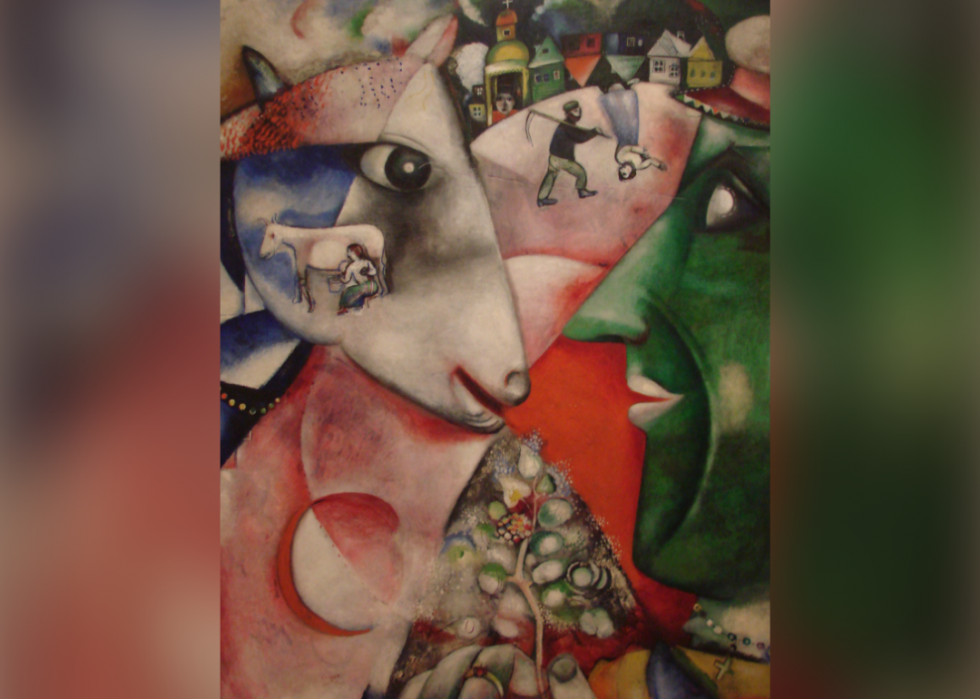
47 / 50
Allie_Cauflield // Flickr
I and the Village
- Artist: Marc Chagall
- Year: 1911
An ethereal, dream-like romanticism infuses Russian expat Marc Chagall's vision of life on the shtetl in "I and the Hamlet." Heavy on symbolism, the painting demonstrates a Cubist influence, to which the immature Chagall was exposed while living in Paris.
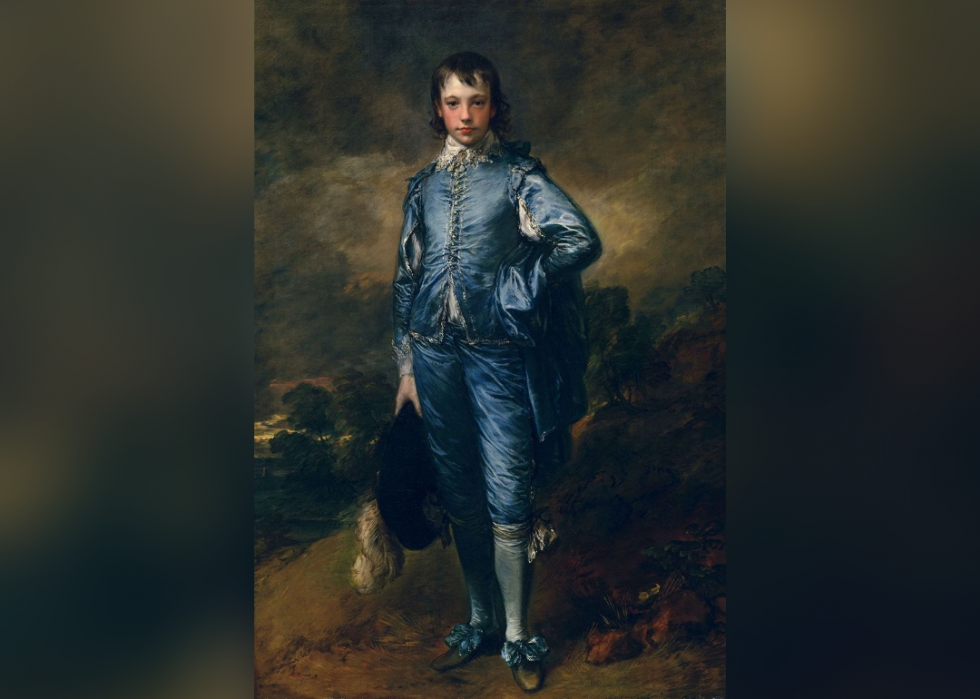
48 / 50
Public Domain // Wikimedia Commons
The Blueish Male child
- Creative person: Thomas Gainsborough
- Year: 1770
Gainsborough's "Blueish Boy" was an immediate striking when it get-go debuted at London's Majestic University of Arts and continues to be reproduced for popular consumption. Believed to be a portrait of Jonathan Buttall, whose male parent was a friend of Gainsborough, Buttall endemic the painting until defalcation forced him to sell information technology.
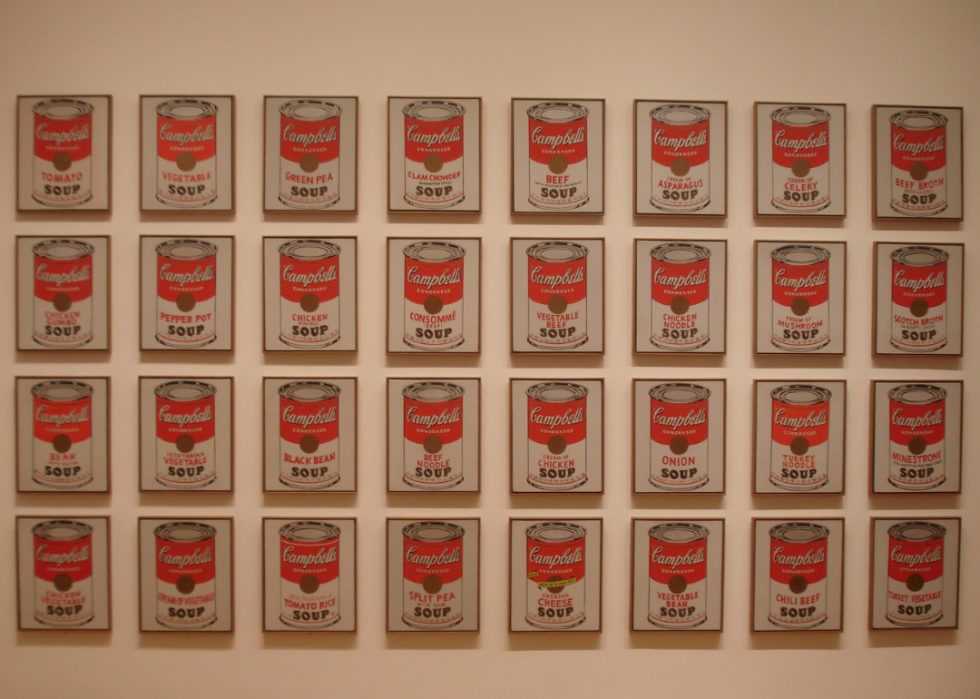
49 / 50
Campbell's Soup Cans
- Artist: Andy Warhol
- Year: 1962
The panels composing Andy Warhol's "32 Campbell'south Soup Cans" were almost separated for all eternity when they were first exhibited at Los Angeles' Ferus Gallery. The paintings were an immediate hitting, and owner Irving Blum sold five of them before coming to the shrewd realization that the canvases would exist of fifty-fifty greater value as a complete fix. Blum tracked downward the paintings that had sold (including one belonging to actor Dennis Hopper), and reunited them.
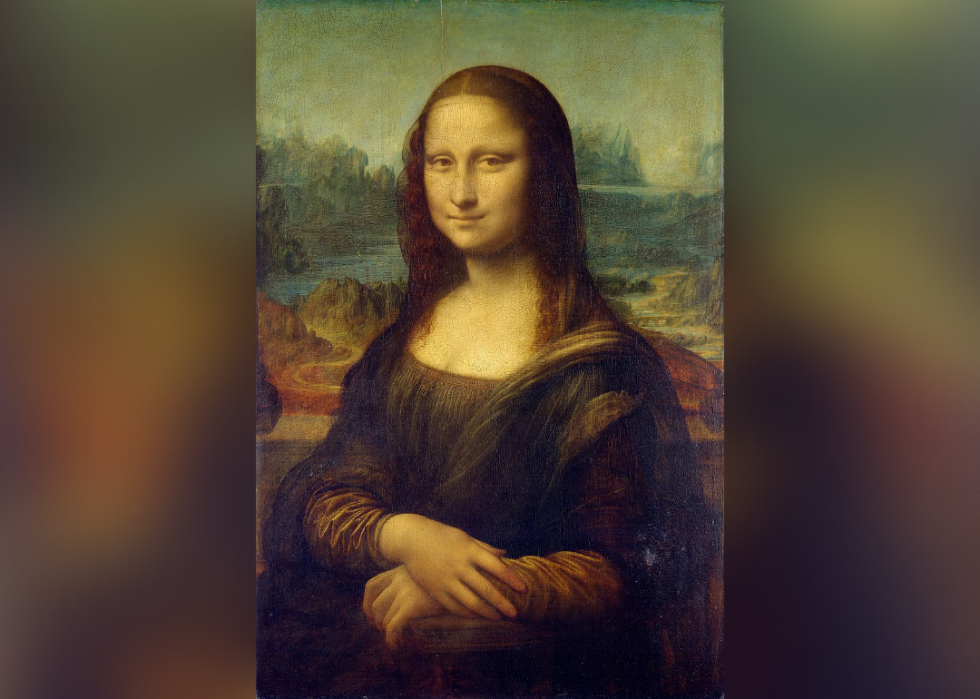
50 / 50
Public Domain // Wikimedia Commons
Mona Lisa
- Artist: Leonardo da Vinci
- Year: 1503
Leonardo da Vinci's woman of mystery has intrigued viewers for centuries. Traditionally identified as Italian noblewoman Lisa Del Giocondo, countless hypotheses accept been put along equally to the sitter's identity every bit well as explanations for her seemingly enigmatic smiling. Extensive multi-spectral imaging conducted by Lumiere Technology in 2006, which uncovered years of varnish, didn't shed any light equally to the reasons behind the Mona Lisa'due south facial expression, but it did reveal that her smile was originally broader than information technology appears today.
You lot may also like: The 51 women who have won the Nobel Prize
Trending Now
© Stacker 2022. All rights reserved.
Source: https://stacker.com/stories/3484/50-famous-paintings-and-stories-behind-them
0 Response to "Famous Works of Art That Took a Long Time"
Post a Comment